 Creation index
 |
Seminar 6 The Hovind Theory, part b |
 |
(this seminar was given in 2005) |
| [Introduction to Dr. Hovind], [Dr. Hovind's justice cycle], [Is Dr. Hovind being edited?], [Dr. Hovind vs Wikipedia] |
| [Video presentation of seminars 1-7], [Introduction to seminar transcripts], [Seminar 1: “The Age of the Earth”],
[Seminar 2: “The Garden of Eden”],
[Seminar 3: “Dinosaurs and the Bible”],
[Seminar 4: “Lies in the Textbooks?”],
[Seminar 5: “The Dangers of Evolution”],
[Seminar 6: “The Hovind Theory”],
[Seminar 7: “Question and Answers”] |
| |
| |
“And God remembered Noah, and every living thing, and all the cattle that was with him in the ark: and God made a wind to pass over the earth, and the waters assuaged; |
|
| |
 The fountains also of the deep and the windows of heaven were stopped, and the rain from heaven was restrained; |
|
| |
 And the waters returned from off the earth continually: and after the end of the hundred and fifty days the waters were abated.” |
|
| |
|
Genesis 8:1-3 |
|
Seminar 6: The Hovind Theory (part b)
Go to “The Hovind Theory” index page
 4) The earth's crust cracked releasing the fountains of the deep, causing the earth to wobble, and made the pre-Flood water canopy collapse 4) The earth's crust cracked releasing the fountains of the deep, causing the earth to wobble, and made the pre-Flood water canopy collapse
And then this super cold ice at the pole would send off a cold wave. Like when you open the freezer and the cold air comes out and falls at your feet. This cold air hitting warm air would cause it to rain. And it rained forty days and forty nights, the canopy collapsed. The Bible says: “All the fountains of the deep were broken up in one day.”
| |
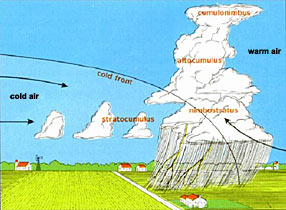 |
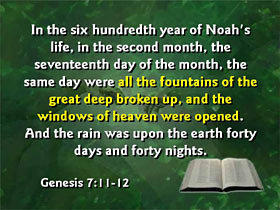 |
If you read the book of Jasher; you can get it from our ministry, I cannot verify it's legitimate; the actual book of Jasher referred to in the Bible. There is a book of Jasher referred to in the Bible. This may or may not be it, I don't know. But it is interesting reading nonetheless. In the book of Jasher it says: “And on that day the Lord caused the whole earth to shake, and the sun darkened, and the foundations of the world raged, and the whole earth was moved violently. And lightening flashed, and the thunder roared, and all the foundations in the earth were broken up.” Jasher, chapter 6 (v. 11). Interesting. I think what happened, the dump of ice on the poles caused the earth's crust to crack. Ice spread out toward the equator, buried the mammoths, made the earth wobble, and earth was totally covered by water. The Bible says: “All the high hills were covered.” (Gen. 7:19) This may or may not be it, I don't know. But it is interesting reading nonetheless. In the book of Jasher it says: “And on that day the Lord caused the whole earth to shake, and the sun darkened, and the foundations of the world raged, and the whole earth was moved violently. And lightening flashed, and the thunder roared, and all the foundations in the earth were broken up.” Jasher, chapter 6 (v. 11). Interesting. I think what happened, the dump of ice on the poles caused the earth's crust to crack. Ice spread out toward the equator, buried the mammoths, made the earth wobble, and earth was totally covered by water. The Bible says: “All the high hills were covered.” (Gen. 7:19)
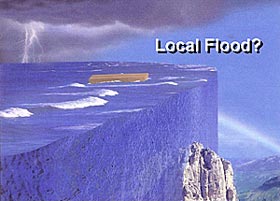 Now there are some idiots out there teaching it was just a local flood in the days of Noah. The Bible says: “The high hills were covered.” It is not a local flood. If the earth were reduced down to the size of this globe right here, all the oceans in the world would only fill about one table spoon. If you smoothed out the earth, the oceans right now, would be average 12,000 feet (3,700 m) deep. But if you smoothed out the earth, they would average 8,000 feet (2,500 m) deep everywhere. There is plenty of water on the earth to cover the planet. Technically, one drop of water would cover the planet, if you spread it real thin, I mean, real thin. I flew back over the Pacific one time, and I came back and said to one of the guys in my office, I said: “Man, that Pacific ocean is huge.” He said: “That's just the top of it.” Wow, what a thought. That is just the top of it. There is a lot of water in these oceans out there. Now there are some idiots out there teaching it was just a local flood in the days of Noah. The Bible says: “The high hills were covered.” It is not a local flood. If the earth were reduced down to the size of this globe right here, all the oceans in the world would only fill about one table spoon. If you smoothed out the earth, the oceans right now, would be average 12,000 feet (3,700 m) deep. But if you smoothed out the earth, they would average 8,000 feet (2,500 m) deep everywhere. There is plenty of water on the earth to cover the planet. Technically, one drop of water would cover the planet, if you spread it real thin, I mean, real thin. I flew back over the Pacific one time, and I came back and said to one of the guys in my office, I said: “Man, that Pacific ocean is huge.” He said: “That's just the top of it.” Wow, what a thought. That is just the top of it. There is a lot of water in these oceans out there.
 Petrified clams on top of mountains Petrified clams on top of mountains
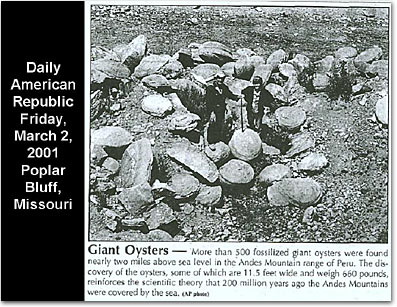 When the climbers got to the top of Mount Everest, 1953, the year I was born, they got up here on Mount Everest. They began to find something interesting, petrified clams, on top of Mount Everest. In Peru a couple years ago they found giant oysters up to 11 feet (3 m) across, 2 miles (3 km) above sea level. That's a big oyster. You should see the pearl! And these clams are interesting. I got some on the table down here. They are petrified clams in the closed position. Now think about it for a minute. When a clam dies it opens. The muscle inside relaxes, the ligaments on the outside pull the shell open, almost instantly. When a clam dies, it opens up. How would you get bazillions of petrified clams in the closed position on top of mountains all over the world. When the climbers got to the top of Mount Everest, 1953, the year I was born, they got up here on Mount Everest. They began to find something interesting, petrified clams, on top of Mount Everest. In Peru a couple years ago they found giant oysters up to 11 feet (3 m) across, 2 miles (3 km) above sea level. That's a big oyster. You should see the pearl! And these clams are interesting. I got some on the table down here. They are petrified clams in the closed position. Now think about it for a minute. When a clam dies it opens. The muscle inside relaxes, the ligaments on the outside pull the shell open, almost instantly. When a clam dies, it opens up. How would you get bazillions of petrified clams in the closed position on top of mountains all over the world.
I would like to point out, your honor that:
- Mount Everest is a little ways from the beach;
- Clams do not climb mountains very well;
- When a clam dies it opens.
The best explanation for this is, they were buried alive. Sometimes huge beds of these are found. A guy in Alabama said: “Brother Hovind, do you want some petrified clams for your museum?” I said: “Yeah!” He said: “They are four feet thick in my backyard.” When he rototills his garden he brings up thousands of petrified clams, closed petrified clams. We've got a bunch in our museum down in Pensacola, Florida.
 Other fossils found Other fossils found
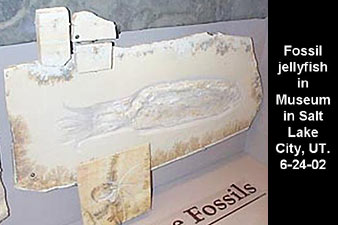 Even fragile items like eggs are found fossilized. I believe the sediments would settle out of this flood; fine sediments would preserve things in incredible detail. Here is a fossilized jelly fish. We have a fossilized octopus arm in our museum. Soft tissue simply doesn't fossilize under...; very special conditions are required. The Bible says: “The fountains of the deep broke open.” I think the earth got struck by a meteor, the water underneath went shooting to the surface, and the earth was covered with water. See, the earth's crust is kind of interesting. Even fragile items like eggs are found fossilized. I believe the sediments would settle out of this flood; fine sediments would preserve things in incredible detail. Here is a fossilized jelly fish. We have a fossilized octopus arm in our museum. Soft tissue simply doesn't fossilize under...; very special conditions are required. The Bible says: “The fountains of the deep broke open.” I think the earth got struck by a meteor, the water underneath went shooting to the surface, and the earth was covered with water. See, the earth's crust is kind of interesting. 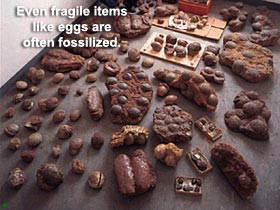 Pretty thin actually in some spots; 3 to 5 miles (5-8 km) thick under the oceans, and 30 miles (50 km) thick under the continents. The hot water from inside the earth would come shooting out, and it would kill animals that lived within a certain radius of the crack, as the hot water escaped. As the basalt bulged up in the middle, the plates are gonna slide down, explaining as I said earlier about the wrinkled mountains. Take a look at these mountains in British Columbia. They've been pressed from the end, wrinkled up. What happened? As the water came shooting out, the hot water would kill all sorts of things within a certain radius. If you poured a gallon of boiling water into your aquarium it would kill all the fishes within a certain distance, ok. Until the temperature dissipated. Pretty thin actually in some spots; 3 to 5 miles (5-8 km) thick under the oceans, and 30 miles (50 km) thick under the continents. The hot water from inside the earth would come shooting out, and it would kill animals that lived within a certain radius of the crack, as the hot water escaped. As the basalt bulged up in the middle, the plates are gonna slide down, explaining as I said earlier about the wrinkled mountains. Take a look at these mountains in British Columbia. They've been pressed from the end, wrinkled up. What happened? As the water came shooting out, the hot water would kill all sorts of things within a certain radius. If you poured a gallon of boiling water into your aquarium it would kill all the fishes within a certain distance, ok. Until the temperature dissipated.
| |
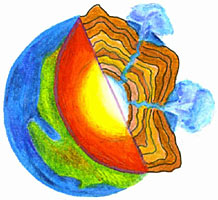 |
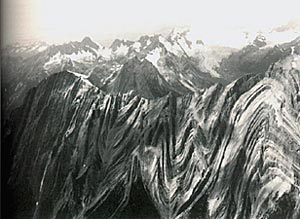 |
 Diatomaceous earth ...and the whale Diatomaceous earth ...and the whale
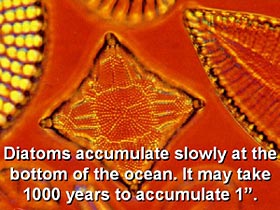 All over the world little tiny creatures called diatoms are found dead in great big thick beds called, diatomaceous earth. These diatoms are super tiny. It takes about 1,000 years to get an inch of dead diatoms at the bottom of the ocean. They very slowly accumulate. When it dries out they pack it into a special powder called, diatomaceous earth. It is used for all sorts of things. It is used as kitty litter. It is used as oil dry. Diatomaceous earth is used in swimming pool filters. Used in bricks, used in aspirin, it's used in medicines, it's used in all sorts of strange things you would never think of; diatomaceous earth, because it is so absorbent. All over the world little tiny creatures called diatoms are found dead in great big thick beds called, diatomaceous earth. These diatoms are super tiny. It takes about 1,000 years to get an inch of dead diatoms at the bottom of the ocean. They very slowly accumulate. When it dries out they pack it into a special powder called, diatomaceous earth. It is used for all sorts of things. It is used as kitty litter. It is used as oil dry. Diatomaceous earth is used in swimming pool filters. Used in bricks, used in aspirin, it's used in medicines, it's used in all sorts of strange things you would never think of; diatomaceous earth, because it is so absorbent.
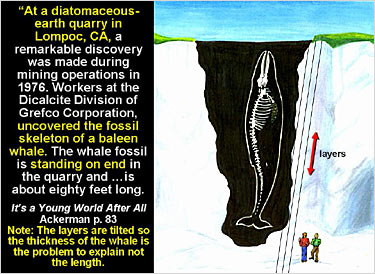 I was in Lompoc, California, preaching, and I went to visit the world's largest diatomaceous earth quarry. I was in Lompoc, California, preaching, and I went to visit the world's largest diatomaceous earth quarry. I believe it's the world's largest. There in Lompoc, California, which is right smack on top of the San Andreas Fault. There in Lompoc, California, back in 1976, they found the fossil skeleton of a whale standing on end, 80 feet (25 m) long, running through diatomaceous earth. Now, I know the whale is parallel with the layers, that's ok, because the layers are tilted up also. So the thickness of the whale becomes the problem, not the length. But still, if this stuff accumulates an inch every 1,000 years, how long is a dead whale gonna lay there waiting for this stuff to gather around him? Dead whales are dissolved at the bottom of the ocean in a few weeks or months. Even the bones eventually disappear. They gave me a chunk of their diatomaceous earth out there. I believe it's the world's largest. There in Lompoc, California, which is right smack on top of the San Andreas Fault. There in Lompoc, California, back in 1976, they found the fossil skeleton of a whale standing on end, 80 feet (25 m) long, running through diatomaceous earth. Now, I know the whale is parallel with the layers, that's ok, because the layers are tilted up also. So the thickness of the whale becomes the problem, not the length. But still, if this stuff accumulates an inch every 1,000 years, how long is a dead whale gonna lay there waiting for this stuff to gather around him? Dead whales are dissolved at the bottom of the ocean in a few weeks or months. Even the bones eventually disappear. They gave me a chunk of their diatomaceous earth out there.
| |
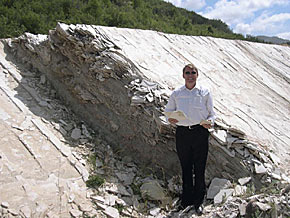 |
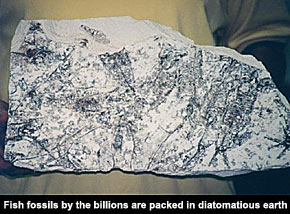 |
In that one little square foot there are dozens, maybe even up to 60 fish skeletons. You know, fish skeletons are found in diatomaceous earth and they are found with their gills extended, their fins extended; they died terrified. Whatever was happening to them was terrifying these creatures. Fossil fish are found by the trillions. The chalk cliffs of Dover, England are found this way. Chalk, from the Latin word ‘creta’ which means chalk. Chalk 300 feet (90 m) thick. It was a catastrophe that formed all this. The Bible says: “The waters prevailed upon the earth.” (Gen. 7:18) I think what happened during the first part of the Flood, dead things settled out. And that Flood represents God's judgment on this planet.
 5) Great piles of dead plants and animals were deposited and turned to coal and oil 5) Great piles of dead plants and animals were deposited and turned to coal and oil
Point #5 of the Hovind Theory is, during the first few months of the Flood the dead animals would settle out. People ask: “Why aren't more human fossils found?” Well, humans are smarter than animals, some humans are, and some animals. And they would tend to avoid drowning till the last possible minute. Animals that are buried on top or very very shallow soil aren't going to fossilize. Think of all the millions of buffalo that were killed out west in the last few hundred years. None of them fossilized, because they weren't buried. So, fossils only form if an animal is buried pretty deeply and pretty quickly, before it has time to decay. Marvin Lubenow says: “About 4,000 sets of human remains have been found.” I think there are fewer humans than animals found fossilized, because they were smarter and would avoid drowning till later in the Flood. And therefore they're not gonna be fossilized. We cover more on that on video 7. The trees that are uprooted would float around in big log mats the size of Texas. They're gonna be buried and become the coal seams that we see today. I think there are fewer humans than animals found fossilized, because they were smarter and would avoid drowning till later in the Flood. And therefore they're not gonna be fossilized. We cover more on that on video 7. The trees that are uprooted would float around in big log mats the size of Texas. They're gonna be buried and become the coal seams that we see today.
 Stratigraphy (stratification) Stratigraphy (stratification)
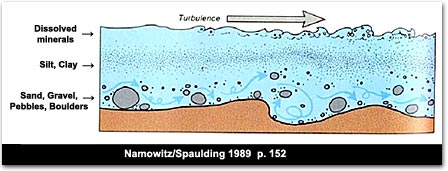 Moving water does very interesting phenomena. As water is moving it automatically sorts things. It can form five or six layers simultaneously. There is a good video tape called: Experiments in Stratification that shows the top strata can Moving water does very interesting phenomena. As water is moving it automatically sorts things. It can form five or six layers simultaneously. There is a good video tape called: Experiments in Stratification that shows the top strata can 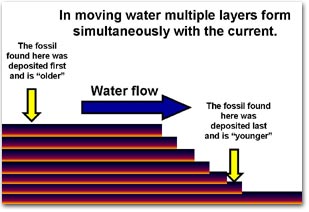 actually be older than the bottom strata. If the water if moving, it forms multiple layers simultaneously. Moving water does some strange things. How many have ever seen those things you buy at the store with two pieces of glass and different colored sand in between? When you flip it over it forms all these layers real quickly, ok. It doesn't take a long time, stratification can happen very quickly. Underwater landslides, like the one we saw in Indonesia in 2004, it is called a turbidity current, they can do enormous damage under water. Causing tsunamis on the surface which killed 250,000 people. In 1929 there was an underwater landslide that traveled 70 miles (110 km) an hour; cut two Transatlantic cables. That one landslide covered 40,000 square miles. That's about the size of Ohio. One landslide underwater. actually be older than the bottom strata. If the water if moving, it forms multiple layers simultaneously. Moving water does some strange things. How many have ever seen those things you buy at the store with two pieces of glass and different colored sand in between? When you flip it over it forms all these layers real quickly, ok. It doesn't take a long time, stratification can happen very quickly. Underwater landslides, like the one we saw in Indonesia in 2004, it is called a turbidity current, they can do enormous damage under water. Causing tsunamis on the surface which killed 250,000 people. In 1929 there was an underwater landslide that traveled 70 miles (110 km) an hour; cut two Transatlantic cables. That one landslide covered 40,000 square miles. That's about the size of Ohio. One landslide underwater.
 Fossilization principles, criteria and petrified artifacts Fossilization principles, criteria and petrified artifacts
During the Flood the water would be swirling around. And the dead animals would. you know, get caught in these little swirls called eddies. This happens today, if you walk along the river You see the river going one direction, but along the sides there are little eddies swirling water. This would happen on a global scale during the Flood of Noah. As the animals would float around for a few weeks, they would rot. And their head falls off, the tail falls off, and legs fall off. And when they finally get buried you end up with tangled messes of dinosaur bones. Notice these backbones here have no head attached, no legs, just the backbone. Underwater landslides do enormous damage, and animals buried on the surface under mud can be in tangled up messes. Fossil graveyards are very common all over the planet. They have found concentrations of fossils like logs in a log jam.![“Wyoming. [A 1934 discovery by Barnum Brown, famous dinosaur discoverer, on ranch owned by Barker Howe, who lived at the foot of the Big-Horn Mountains in Wyoming] ‘The concentration of the fossils was remarkable; they were piled in LIKE LOGS IN A JAM’”
-- Men and Dinosaurs, Edwin Colbert, p 173](../image-files/sup_txt/ref.jpg)
| |
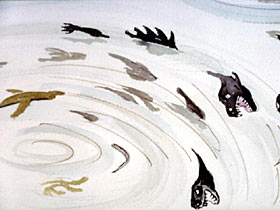 |
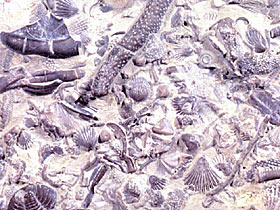 |
If you go to San Juacito Monument in Texas; where Santa Anna finally met his match when the Texans caught up with him; the whole monument is made out of fossils. I mean, you look at the blocks of rock, it looks like great big blocks of stones, and they are; as you get up closer, there are bazillions of little tiny fossils in them.
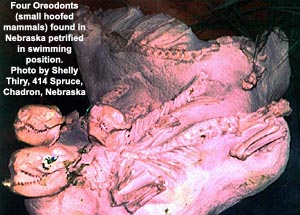 Here is four animals that are found fossilized in the swimming position. Their heads held up high out of the water. I beleive they probably got caught in the mud as the mud settled under the water. And they drowned or died in this swimming position. In one place in Africa called the Karroo formation, they said: “There are 800,000 million skeletons of vertebrate animals.” Here is four animals that are found fossilized in the swimming position. Their heads held up high out of the water. I beleive they probably got caught in the mud as the mud settled under the water. And they drowned or died in this swimming position. In one place in Africa called the Karroo formation, they said: “There are 800,000 million skeletons of vertebrate animals.” A lot of animals died at one time. They found “Iguanodon skeletons in a Belgian coal mine,” extending “through 100 feet (30 m) of rock in the vertical position.” A lot of animals died at one time. They found “Iguanodon skeletons in a Belgian coal mine,” extending “through 100 feet (30 m) of rock in the vertical position.” Up in Canada on Axel Island, they find petrified redwood stumps. Up in Canada on Axel Island, they find petrified redwood stumps. You can go to Axel Island. There are no trees on Axel Island. There are certainly no redwood trees growing there. How do we get fossilized redwood stumps on Axel Island? You can go to Axel Island. There are no trees on Axel Island. There are certainly no redwood trees growing there. How do we get fossilized redwood stumps on Axel Island?
People say: “Hey, doesn't it that take millions of years for something to petrify?” No, things petrify quickly. There are scores of examples can be given of things that have petrified in less than 100 years, ok.
[take note: additonal illustrations and examples not shown here below can be consulted here, separate window]
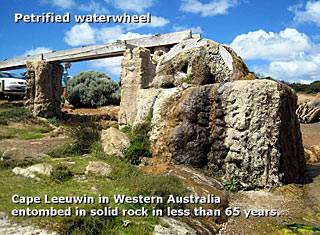 Two horse hooves were found petrified in Oregon. Two horse hooves were found petrified in Oregon. - A petrified water wheel, shown here in this picture. Just the minerals replaced the wood.
- Here is petrified firewood.

- Here is a fishing reel stuck in a rock. They said, the rock was “300 million years” old.
 By the way, if any of you students wanna make some money. The University of Tennessee in Chattanooga (UTC), studied this thing. Talked to the guy who owned it and analyzed the whole thing, said: “Man, this is amazing, a reel stuck in a rock.” By the way, if any of you students wanna make some money. The University of Tennessee in Chattanooga (UTC), studied this thing. Talked to the guy who owned it and analyzed the whole thing, said: “Man, this is amazing, a reel stuck in a rock.” 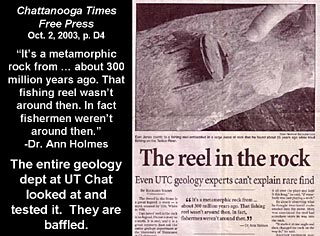 If you can locate the owner of the reel, and get me in touch with him, I wanna see if he wants to put it on loan in our museum. And anybody who can find me the owner Dan Jones, find me the guy, get me his phone number, and let me talk to him, I'll give you $50. Do some research, if some slouch up here in Tennessee wanna work on that one. “UTC geology experts cannot explain this.” How could a fishing reel be found in rock? If you can locate the owner of the reel, and get me in touch with him, I wanna see if he wants to put it on loan in our museum. And anybody who can find me the owner Dan Jones, find me the guy, get me his phone number, and let me talk to him, I'll give you $50. Do some research, if some slouch up here in Tennessee wanna work on that one. “UTC geology experts cannot explain this.” How could a fishing reel be found in rock?
- If you go to Waycross, Georgia, they've got on display there at the Southern Forest World, a mummified dog stuck in a tree.
 The dog apparently chased a coon up the tree, and got stuck, and the dog is mummified. The tree was still alive. They named the dog, ‘Stucky’. The dog apparently chased a coon up the tree, and got stuck, and the dog is mummified. The tree was still alive. They named the dog, ‘Stucky’.
- Here's a petrified cowboy boot with the cowboy's leg still in it. The article is on the table down there, called the Limestone Cowboy.

- Here is a petrified fish giving birth.

- Here is a petrified hammer found in Hawaii.
- A petrified hat found in New Zealand.
| |
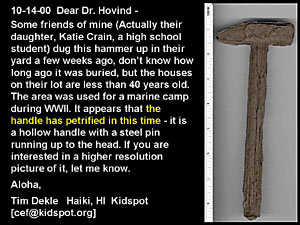 |
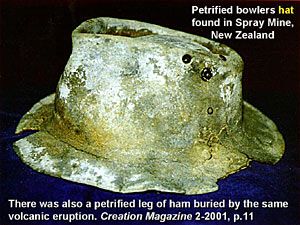 |
- A petrified crayon found in Arizona.

- A petrified pincushion found in Wisconsin.

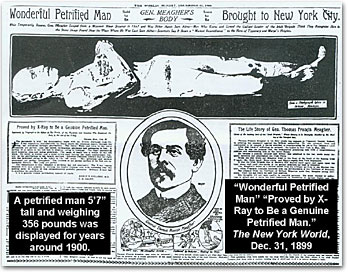 A guy got found along a beach in Montana, that was petrified, a petrified man. The man found in Fort Benton, Montana; it was in 1897, found by Tom Dunbar; the guy was 5 feet, 8 inches tall. Many medical doctors examined him. They said: “Man, this is a petrified complete human, not [just] the bones, the complete person, petrified.” A guy got found along a beach in Montana, that was petrified, a petrified man. The man found in Fort Benton, Montana; it was in 1897, found by Tom Dunbar; the guy was 5 feet, 8 inches tall. Many medical doctors examined him. They said: “Man, this is a petrified complete human, not [just] the bones, the complete person, petrified.”
 [notice: the remains have since disappeared (1922) and there are disputes involved regarding its authenticity [notice: the remains have since disappeared (1922) and there are disputes involved regarding its authenticity ] ]
- There is a story about a petrified man in Gainesboro, Tennessee. The guy died in 1881. They buried him. Fourteen years later they were going to bury his wife next to him when she died. They dug a hole for grandma's grave and water seeped into the hole into the grave. They said: “Oh, we don't wanna bury grandma in the water.” So they buried grandma someplace else. Then the kids got worried about grandpa, buried in the water. So they dug up the grave. The body inside had turned to stone, except the arms had rotted off. The rest of the body had petrified in 14 years in a coffin in Tennessee.

- A lady in São Paulo, Brazil, 62 years old, went to the doctor and said: “I've got a pain in my side.” They X-rayed her and found a petrified skeleton of a baby inside. She was pregnant and didn't know it. The baby had died and turned to stone inside the woman's body. It does appear the baby was about to be born, the doctor said who examined her.

- I talked to a guy from Maryland, he said: “Yeah, I drove the ambulance; we took a woman to the hospital one time in Snowden, Washington.” There's his phone number there, if you wanna talk to Brian. She was taken to the hospital, and they removed a petrified fetus from this woman. It had turned to stone in her body.

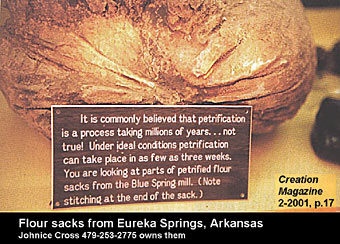 Here are petrified sacks of flour found in Eureka Springs, Arkansas. Here are petrified sacks of flour found in Eureka Springs, Arkansas. - Here is a petrified pickle found in Montana. This is now in my museum. It was found in this jar. The guy who sent it to me said: “Brother Hovind, I found a petrified pickle inside a jar. The lid rusted off. Would you want it for your museum?” I said: “Of course. Who in their right mind would not want a petrified pickle for their museum?”

- Here is a petrified toadstool just south of Bloomington, Illinois, in an amazing museum called the Funk Gem and Mineral Museum, in Shirley, Illinois. If you ever drive out there, stop and see that place.

- This kid in the picture sent me these petrified acorns.
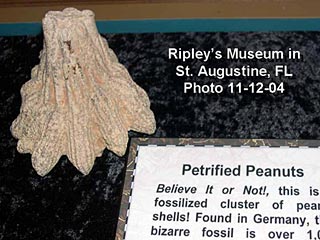 He's seven years old. He said: “Brother Hovind, I put these acorns in a bucket of water hoping they would sprout. And, I forgot about them.” A year later when mama found them on the back porch. They had turned to stone in a bucket of water. Petrified acorns. He's seven years old. He said: “Brother Hovind, I put these acorns in a bucket of water hoping they would sprout. And, I forgot about them.” A year later when mama found them on the back porch. They had turned to stone in a bucket of water. Petrified acorns.
- Here is a petrified peanut cluster in the Ripley's Museum in Florida.
- Here are petrified charcoal briquettes. We've got them in our museum. Come down to Pensacola and see the petrified charcoal briquettes.

- Here is what appears to be a petrified coconut. The whole thing it's in our museum in Pensacola.
- Here is a fossilized arm to an octopus, I referred to earlier. This is a replica of it. Petrified octopus arm.

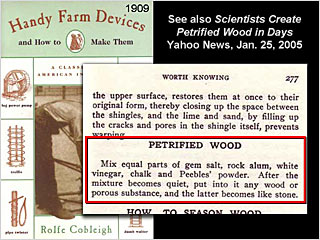 There is an article in Handy Farm Devices published 1909 on how to make petrified wood. For centuries people have known how to make petrified wood, so that it'll last longer. There is an article in Handy Farm Devices published 1909 on how to make petrified wood. For centuries people have known how to make petrified wood, so that it'll last longer.
People say: “Now, wait a minute, aren't the fossils of similar animals found in the same layers, doesn't that prove, you know, evolution, because reptiles are found in the same layer?” Well, if there is any sorting of the fossils, it's not proof of evolution. That's for sure.
- Actually the textbooks teach the layers are well sorted, and it is simply not true. This guy, David Robb, he is a professor at University of Chicago, I believe. He says: “One of the ironies of the evolution-creation debate is that creationists have accepted the mistaken notion that the fossil record shows a detailed and orderly progression. And they have gone to great lengths to accommodate this ‘fact’ in their Flood geology.”
 The layers are not in the order they would like for you to think they are. The layers are not in the order they would like for you to think they are.
- The name and age of the layer is determined by the fossils it contains.
 Niles Eldredge said: “And this poses something of a problem: if we date the rocks by their fossils, how can we then turn around and talk about patterns of evolutionary change through time in the fossil record?” Niles Eldredge said: “And this poses something of a problem: if we date the rocks by their fossils, how can we then turn around and talk about patterns of evolutionary change through time in the fossil record?”  It's circular reasoning.* It's circular reasoning.*
- If there is any sorting to the fossil record it is better explained by a Flood.
[* For clarity reasons I have adapted the spoken words of Dr. Hovind with what it reads on the seminar slide. Dr. Hovind only had said at #2: “Niles Eldredge said: “We date the layers by the fossils, and we date the fossils by the layers.” It's circular reasoning.”]
 Forces of water: Cavitation, hydraulic plucking, abrasion and liquefaction Forces of water: Cavitation, hydraulic plucking, abrasion and liquefaction
See, moving water in a Flood situation does all sorts of interesting things.
Cavitation: There is a phenomena called cavitation. 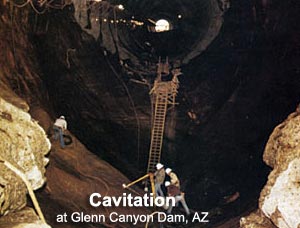 Which is what happened at the Glenn Canyon Dam in Arizona. The water got moving too fast; it sucked the sides of the rock right off the canyon wall. Within just about 20 seconds it made an area the size of a basketball court, four feet deep. Sucking rocks right off the sides because of cavitation. Which is what happened at the Glenn Canyon Dam in Arizona. The water got moving too fast; it sucked the sides of the rock right off the canyon wall. Within just about 20 seconds it made an area the size of a basketball court, four feet deep. Sucking rocks right off the sides because of cavitation.
Hydraulic plucking, abrasion: There is another phenomena called hydraulic plucking, as in addition to abrasion. Moving water in the Flood would pick up debris. And it is not just water moving now, it is liquid sandpaper. It's got gravel, and rocks, and mud, and tree stumps and stuff in it. It's gonna erode right through solid rock. It is gonna upbraid its way through rock.
Liquefaction: Also there is a phenomena called liquefaction. Liquefaction happens when sand grains are pressed and then the pressure is relieved. If you go out to the beach in Pensacola, walk out into the surf and stand there knee deep in the water, and just stand there for a while. As the waves come by, the high part of the wave weighs more than the low part of the wave obviously, there is more water there. So, the high part of the wave pushes down the sand under your feet, when the low part comes past you, the pressure is relieved. And sand grains start hopping up off the bottom as the water squeezes out of them. This phenomena is called, liquefaction.
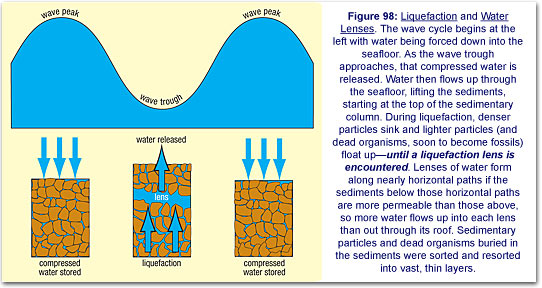 |
What would happen during a worldwide Flood; as the earth is turning under the moon; you would get tides that would go up and down about 200 feet (60 m). A 200 foot tidal change every 6 hours and 25 minutes. So the liquefaction would be incredible worldwide, because of this Flood. It would raise the water 200 feet which pushes on the sediments, and then the pressures relieved, which would cause all kinds of sorting to happen very quickly.
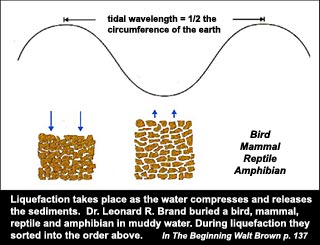 One guy took a giant aquarium and he put a hot water bottle in the bottom, a big rubber bladder. He put a bazillion little holes in it, and he it hooked to a hose. He put this in the bottom of his aquarium. empty aquarium. And then he took a cement mixer and mixed up rocks, gravel, sand, all kinds of stuff, mixed them together; including dead fish, amphibians, reptiles, and mammals. Mixed them all together and dumped them into the aquarium. When he turned the hose on, the aquarium began filling from the bottom, as the water is going through this hot water bottle. Well, as it lifts up from the water coming up, it's gonna automatically lift things, and they are gonna fall back down, liquefaction; and they are gonna sort themselves by density. He discovered, as it filled the aquarium, it sorted everything in the order of birds, mammals, reptiles, and amphibians. Well, that is the order they are gonna tell you they evolved in. If you just remember the word ‘FARM’; F-A-R-M; fish would be at the bottom: Fish, Amphibian, Reptile, Mammal. One guy took a giant aquarium and he put a hot water bottle in the bottom, a big rubber bladder. He put a bazillion little holes in it, and he it hooked to a hose. He put this in the bottom of his aquarium. empty aquarium. And then he took a cement mixer and mixed up rocks, gravel, sand, all kinds of stuff, mixed them together; including dead fish, amphibians, reptiles, and mammals. Mixed them all together and dumped them into the aquarium. When he turned the hose on, the aquarium began filling from the bottom, as the water is going through this hot water bottle. Well, as it lifts up from the water coming up, it's gonna automatically lift things, and they are gonna fall back down, liquefaction; and they are gonna sort themselves by density. He discovered, as it filled the aquarium, it sorted everything in the order of birds, mammals, reptiles, and amphibians. Well, that is the order they are gonna tell you they evolved in. If you just remember the word ‘FARM’; F-A-R-M; fish would be at the bottom: Fish, Amphibian, Reptile, Mammal.
- That's what the evolutionists will say, how they evolved. No, they are not found in that order, number one.
- And if they are found in that order; liquefaction or the Flood best explains it.
There is a whole lot more on that in this book right here by Walt Brown [In the Beginning].
Also, as some layers are less dense, they get covered up by more dense layers. If conditions are just right, the less dense layer will all of a sudden shoot to the top, it will break its way through. And it causes what is called a sand plume. These sand plumes can harden and probably Ayers Rock in Australia is a giant sand plume; best explained by the Flood. If you look at these sand plumes closely you'll see they have air bubbles all over them. That was the air, that tunnels all over them, that was the air coming out.
During an earthquake, the ground can shake and the water in the ground comes to the surface, and the top of the ground can become like soup. There was an earthquake in Japan that sank these buildings. The buildings actually sank into the ground, because of the phenomena called liquefaction; water coming to the surface, settling, sand grains all loose, almost like quick sand.
 Clams found at the bottom, birds found on top, does that prove that clams evolved first and birds last? Clams found at the bottom, birds found on top, does that prove that clams evolved first and birds last?
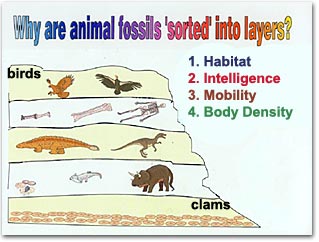 Evolutionists will say: “Hovind, don't you know that birds are found on top? That proves that birds evolved last.” And: “Clams are found at the bottom. That proves clams evolved first.” I say: “Well, there's a better explanation. You know, maybe clams are found at the bottom because of their habitat. You know, that's where they live.” A clam would be the first one buried in a Flood. I mean, he's already at the bottom. Hello! A bird's gonna be the last one buried because he can fly around until he runs out of gas. Maybe they are sorted based upon their intelligence. As far as anyone can figure out, you know, clams are not too bright. Maybe they are sorted based upon their mobility. Clams cannot run very fast. Maybe they are sorted based upon their body density. Clam shells are heavier than bird feathers. So the sorting of the fossils, if there is any, is not explained by evolution. It is much better explained by a Flood. Evolutionists will say: “Hovind, don't you know that birds are found on top? That proves that birds evolved last.” And: “Clams are found at the bottom. That proves clams evolved first.” I say: “Well, there's a better explanation. You know, maybe clams are found at the bottom because of their habitat. You know, that's where they live.” A clam would be the first one buried in a Flood. I mean, he's already at the bottom. Hello! A bird's gonna be the last one buried because he can fly around until he runs out of gas. Maybe they are sorted based upon their intelligence. As far as anyone can figure out, you know, clams are not too bright. Maybe they are sorted based upon their mobility. Clams cannot run very fast. Maybe they are sorted based upon their body density. Clam shells are heavier than bird feathers. So the sorting of the fossils, if there is any, is not explained by evolution. It is much better explained by a Flood.
 Dumb idea: The Flood was just local Dumb idea: The Flood was just local
The Bible says: “The whole earth, the whole world was covered. All the high hills were covered. ...the mountains were covered.” (Gen. 7:19-20) Then “the waters assuaged,” (Gen. 8:1) which means, to drop down. NIV [New International Version] says: “The waters receded.” No-no-no, the waters did not receded and they weren't “wild animals.” NIV got it wrong twice in that verse. They were all perfectly tame animals during the Flood. But the waters didn't recede, “the waters assuaged.”
| |
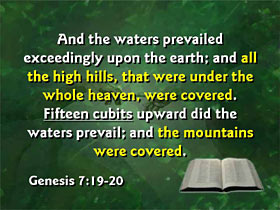 |
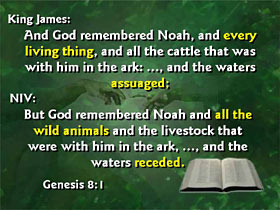 |
The Bible says: “The waters stood above the mountains,” Psalm 104, verse 5-6. Hugh Ross teaches it was a local flood in the days of Noah. Excuse me, “fifteen cubits above the highest mountain,” and it's a local flood? I'd like to see that happen. When I debated Hugh Ross, I said: “Dr. Ross, 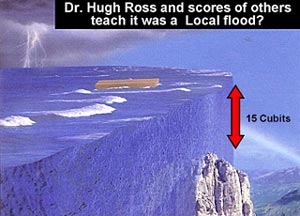 do you believe in a worldwide flood in the days of Noah?” He said: “I believe in a universal flood.” Well, that's just a deceitful answer, ok. I said: “What do you mean, a ‘universal flood’?” He said: “Well, it flooded Noah's little universe. Just..., it flooded the valley that he lived in.” I said: “Will you answer a question then, for me, please? If it's just a local flood that floods Noah's valley, why would God tell Noah to build that huge boat, and then to fill it full of animals, and to stay in there for a year? Why not tell Noah ...to move?” This local flood idea is dumb. Capital D, Dumb, ok! do you believe in a worldwide flood in the days of Noah?” He said: “I believe in a universal flood.” Well, that's just a deceitful answer, ok. I said: “What do you mean, a ‘universal flood’?” He said: “Well, it flooded Noah's little universe. Just..., it flooded the valley that he lived in.” I said: “Will you answer a question then, for me, please? If it's just a local flood that floods Noah's valley, why would God tell Noah to build that huge boat, and then to fill it full of animals, and to stay in there for a year? Why not tell Noah ...to move?” This local flood idea is dumb. Capital D, Dumb, ok!
 6) The unstable plates of the crust of the earth would move around, creating ocean bassins, mountain ranges and canyons 6) The unstable plates of the crust of the earth would move around, creating ocean bassins, mountain ranges and canyons
 Where did all the water go?; If something goes down, something else goes up! Where did all the water go?; If something goes down, something else goes up!
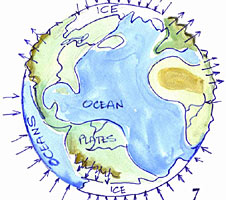 People say: “Well, if the world was covered with water, where did it all go?,” ok. During the last few months of the Flood, the unstable plates of the crust of the earth would began to shift, and in some place sink down. Thin spots would sink down, other places lifted up. The water is gonna rush off and fill in the holes very quickly. It would cause erosion very quickly. The Bible says in Psalm 104 (v. 7-8): “At thy rebuke they fled.” This is talking about the water. “At the voice of thy thunder they hasted away.” The water rushed off. “They go up by the mountains, they go down by the valleys unto the place which thou hast founded for them,” which is, the oceans. What happened was, the mountains lifted up; the water rushed off into the new low places. People say: “Well, if the world was covered with water, where did it all go?,” ok. During the last few months of the Flood, the unstable plates of the crust of the earth would began to shift, and in some place sink down. Thin spots would sink down, other places lifted up. The water is gonna rush off and fill in the holes very quickly. It would cause erosion very quickly. The Bible says in Psalm 104 (v. 7-8): “At thy rebuke they fled.” This is talking about the water. “At the voice of thy thunder they hasted away.” The water rushed off. “They go up by the mountains, they go down by the valleys unto the place which thou hast founded for them,” which is, the oceans. What happened was, the mountains lifted up; the water rushed off into the new low places.
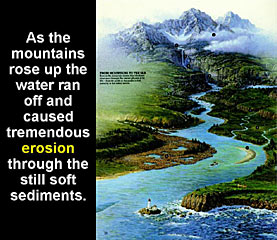 If we filled this auditorium four feet deep in water; preacher would be upset, I'm sure, but...; let's just do it for a science experiment, for the good of science. We're gonna fill the auditorium four feet deep in water, then we're gonna get all the guys in the school to pick up that end of the building, krrr... They pick up that end, all the water is gonna rush down, whoosh..., over to this end of the building. It's common sense. If the earth were covered with water and some places began to sink down, other places are gonna lift up. It is kinda like a water bed. How many have ever slept on a water bed before? You know, my wife is only five feet tall. When she gets sound asleep on a side of the water bed...; I don't like water beds; we don't have one, but we have slept on them a couple of times. You wait till she is sound asleep on her side. I tiptoe in; stand up on a chair, and jump up as high as I can. Shw...boom..., and land on my side of the water bed. She goes, pwhooo..., up to the ceiling, comes down, whehehe..., and I sleep on the couch, because I don't like water beds anyway, but... Sure, if one place goes down, someplace else is going to lift up. The crust of the earth probably did a lot of flexing during the time of Noah's Flood, and probably for the next few hundred or maybe even a few thousand years after the Flood. Actually, I think it is still moving around a little bit, causing the earthquakes. If we filled this auditorium four feet deep in water; preacher would be upset, I'm sure, but...; let's just do it for a science experiment, for the good of science. We're gonna fill the auditorium four feet deep in water, then we're gonna get all the guys in the school to pick up that end of the building, krrr... They pick up that end, all the water is gonna rush down, whoosh..., over to this end of the building. It's common sense. If the earth were covered with water and some places began to sink down, other places are gonna lift up. It is kinda like a water bed. How many have ever slept on a water bed before? You know, my wife is only five feet tall. When she gets sound asleep on a side of the water bed...; I don't like water beds; we don't have one, but we have slept on them a couple of times. You wait till she is sound asleep on her side. I tiptoe in; stand up on a chair, and jump up as high as I can. Shw...boom..., and land on my side of the water bed. She goes, pwhooo..., up to the ceiling, comes down, whehehe..., and I sleep on the couch, because I don't like water beds anyway, but... Sure, if one place goes down, someplace else is going to lift up. The crust of the earth probably did a lot of flexing during the time of Noah's Flood, and probably for the next few hundred or maybe even a few thousand years after the Flood. Actually, I think it is still moving around a little bit, causing the earthquakes.
 There is still water under the crust of the earth There is still water under the crust of the earth
There might still be water under the crust of the earth, trapped. As some of the water escaped during the Hydroplate theory idea, the plate would settle down, trapping water under there. There are still huge areas of trapped water. 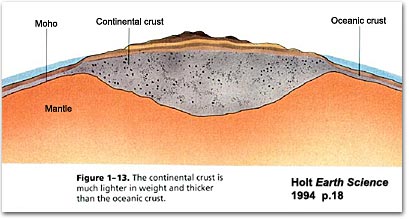 Did you know there are underwater; at the bottom of the ocean; underwater thermal vents? There is hot water squirting up from the bottom of the ocean. Well, duh..., where is it coming from? Doesn't it have to come from down lower than that? There is still water in the crust of the earth, trapped down there. The ocean crust is pretty thin, about 3 to 5 miles (5-8 km) thick. Continental crust is about 30 miles (50 km) thick. Any earth science teacher can tell you that. Did you know there are underwater; at the bottom of the ocean; underwater thermal vents? There is hot water squirting up from the bottom of the ocean. Well, duh..., where is it coming from? Doesn't it have to come from down lower than that? There is still water in the crust of the earth, trapped down there. The ocean crust is pretty thin, about 3 to 5 miles (5-8 km) thick. Continental crust is about 30 miles (50 km) thick. Any earth science teacher can tell you that. 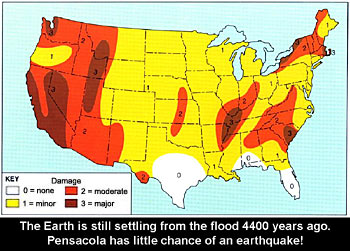 That's been pretty well determined from, you know, reading the S- and P-waves from earthquakes take place. The earth is cracked up, I understand, and a bunch of plates are moving around, and they are still moving a little bit. Pensacola has zero chance of an earthquake according to this map, some places have a real good chance of an earthquake. The cracks have been found and they are still active, still moving. The earth would be like a big water balloon. It would be floating, flexing up and down. Now, we're talking just a few miles, on an 8,000 mile earth. A few miles of movement is close to zero in scale here. The water would run off, causing enormous erosion canyons. That's been pretty well determined from, you know, reading the S- and P-waves from earthquakes take place. The earth is cracked up, I understand, and a bunch of plates are moving around, and they are still moving a little bit. Pensacola has zero chance of an earthquake according to this map, some places have a real good chance of an earthquake. The cracks have been found and they are still active, still moving. The earth would be like a big water balloon. It would be floating, flexing up and down. Now, we're talking just a few miles, on an 8,000 mile earth. A few miles of movement is close to zero in scale here. The water would run off, causing enormous erosion canyons.
Just south of Houston, Texas, they had a flood several years ago, in New Braunfels, Texas. The water went roaring over, as it flooded, overflowed its dam and caused incredible erosion. If you fly out West and just look at some of the erosion patterns, it is unbelievable how much erosion this planet has had. You see the Three Gossips here, the rock spires sticking up out of the ground, or the Penguins, or go see the Arches National Park in Utah, or Bryce Canyon. You see these rocks sticking straight up out of the ground.
 Erosion does not take ‘millions of years...’ Erosion does not take ‘millions of years...’
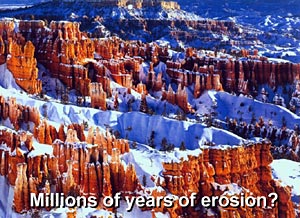 They'll tell you: “It takes millions of years to erode all this stuff. Yes, boys and girls, millions of years of erosion.” I don't think so. That is in my backyard, here's my inkpen on top of it. At a pile of dirt out there, got rained on one time, and it made erosion marks. Here is ‘millions of years’ of erosion, along a highway built a few months ago. There is ‘millions of years’ of erosion? Nooo..., I don't think so. I think that's my glasses sitting right there. Erosion can take place quickly. There are obviously great erosion marks in Washington and Idaho, from the Missoula Flood. There was an ice dam. I believe this would happen after the real Flood of Noah's time, maybe a few hundred years later. Ice caps were melting back, but a big bunch of water got trapped; all of a sudden it released itself, throooth..., shot down to Portland, Oregon. It did incredible erosion. Along the way there is a waterfall, one of the largest waterfalls in the world, called Dry Falls, Washington. But there is no water going over this waterfall; totally dry. But when it was flowing, it was probably bigger than all the waterfalls in the world put together. You can study about Dry Falls, Washington, if you want to read more on that. They'll tell you: “It takes millions of years to erode all this stuff. Yes, boys and girls, millions of years of erosion.” I don't think so. That is in my backyard, here's my inkpen on top of it. At a pile of dirt out there, got rained on one time, and it made erosion marks. Here is ‘millions of years’ of erosion, along a highway built a few months ago. There is ‘millions of years’ of erosion? Nooo..., I don't think so. I think that's my glasses sitting right there. Erosion can take place quickly. There are obviously great erosion marks in Washington and Idaho, from the Missoula Flood. There was an ice dam. I believe this would happen after the real Flood of Noah's time, maybe a few hundred years later. Ice caps were melting back, but a big bunch of water got trapped; all of a sudden it released itself, throooth..., shot down to Portland, Oregon. It did incredible erosion. Along the way there is a waterfall, one of the largest waterfalls in the world, called Dry Falls, Washington. But there is no water going over this waterfall; totally dry. But when it was flowing, it was probably bigger than all the waterfalls in the world put together. You can study about Dry Falls, Washington, if you want to read more on that.
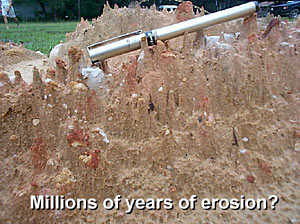 |
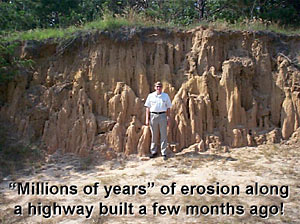 |
 Mountain ranges follow the coastlines, nearly all of them line up Mountain ranges follow the coastlines, nearly all of them line up
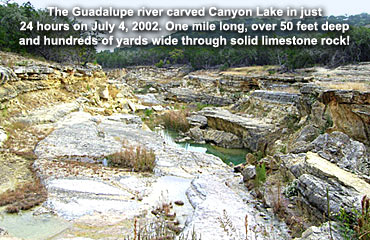 It is also interesting to notice, nearly all of the mountain ranges in the world follow the coastlines. As Walt Brown mentioned in his Hydroplate theory, that is probably because they formed at the same time as the result of the same event. The mountains arose, the valleys sank down. The flood in Texas, the Guadalupe River flooded, had 30 inches of rain in one week. Water overflowed the spillway. And did an unbelievable damage to the area around, you know, this city, when the dam overflowed. It carved a canyon a mile long, 50 feet (15 m) deep, and hundreds of yards wide through solid limestone rock. “Guadalupe River residents rebuilding after flood losses,” interesting, “70 feet (22 m) deep in some places.” It is also interesting to notice, nearly all of the mountain ranges in the world follow the coastlines. As Walt Brown mentioned in his Hydroplate theory, that is probably because they formed at the same time as the result of the same event. The mountains arose, the valleys sank down. The flood in Texas, the Guadalupe River flooded, had 30 inches of rain in one week. Water overflowed the spillway. And did an unbelievable damage to the area around, you know, this city, when the dam overflowed. It carved a canyon a mile long, 50 feet (15 m) deep, and hundreds of yards wide through solid limestone rock. “Guadalupe River residents rebuilding after flood losses,” interesting, “70 feet (22 m) deep in some places.” Now keep in mind it carved this through solid rock. One flood. Little-bitty flood; 30 inches (50 cm) of rain in one week. Now keep in mind it carved this through solid rock. One flood. Little-bitty flood; 30 inches (50 cm) of rain in one week.
 Forming of bent rock layers; Sinkholes in the Grand Canyon Forming of bent rock layers; Sinkholes in the Grand Canyon
Bent rock layers are also found all over the world. These bent rock layers indicate the rock was bent while it was soft. If you bend hard rock, it is going to shatter and make little fracture lines all along the curves. I was at Crystal Cove State Park in Los Angeles, I saw these bent rocks, I went up to get a picture real close, the closer I got, the more confusing it is because there are no fracture lines. All these dozens and dozens of layers were still soft mud while they were bent, and then it hardened. All the layers you see in the earth that are bent, were all soft at the same time. They are not different ages.
| |
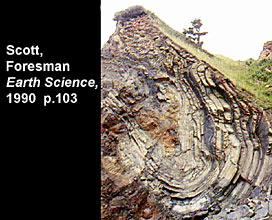 |
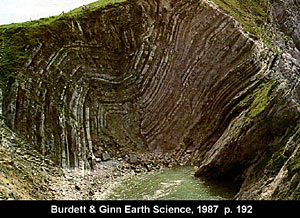 |
 A friend of mine is a pilot. He sent me this picture. He said: “Brother Hovind, as we fly over the Grand Canyon, off to the sides there are sinkholes. The water runs into these holes, and goes down, A friend of mine is a pilot. He sent me this picture. He said: “Brother Hovind, as we fly over the Grand Canyon, off to the sides there are sinkholes. The water runs into these holes, and goes down, 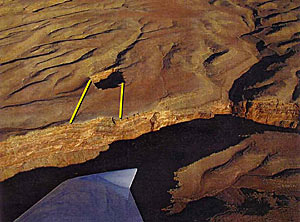 who knows how far, and then squirts out the side of the canyon, into Grand Canyon.” Well, if it keeps eroding away that sinkhole, it's gonna eventually wash out and make another side canyon. After the Flood in Noah's time the surface would dry out first, leaving the inside still soft muddy ground. Which would slowly dry out; as it dries, shrink and contract. Causing wrinkling on the surface. As mountains lifted up it would cause metamorphic rock to be formed. This formed, I believe, during and after Noah's Flood. who knows how far, and then squirts out the side of the canyon, into Grand Canyon.” Well, if it keeps eroding away that sinkhole, it's gonna eventually wash out and make another side canyon. After the Flood in Noah's time the surface would dry out first, leaving the inside still soft muddy ground. Which would slowly dry out; as it dries, shrink and contract. Causing wrinkling on the surface. As mountains lifted up it would cause metamorphic rock to be formed. This formed, I believe, during and after Noah's Flood.
 Kangaroos: How did they get to Australia and why are they only there? Kangaroos: How did they get to Australia and why are they only there?
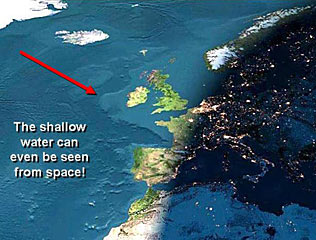 Skeptics say: “Oh wait, excuse me now, how did all these kangaroos get to Australia? And why are they only there?” I believe, after the Flood was over, the oceans were smaller than they are today. Today, of the earth's surface 70% is under water. I don't think it was that way right after Noah got off the Ark. If you look at this map you can see England and Ireland were part of France. If you lower the water just a few hundred feet, everything would dry up in between England and France. That was probably the beach line way out there. You can see it from this satellite view. If you look very carefully you can see that's England and Ireland there. You can see under the water and see the beach line, where it used to be. The water is really very shallow along there. Between Alaska and Russia the water is only 60 feet (20 m) deep. About from here to that pole. Only 60 feet. If you lowered the oceans 60 feet, Russia and Alaska would be connected. If you raised the oceans, all of Central America would flood. Skeptics say: “Oh wait, excuse me now, how did all these kangaroos get to Australia? And why are they only there?” I believe, after the Flood was over, the oceans were smaller than they are today. Today, of the earth's surface 70% is under water. I don't think it was that way right after Noah got off the Ark. If you look at this map you can see England and Ireland were part of France. If you lower the water just a few hundred feet, everything would dry up in between England and France. That was probably the beach line way out there. You can see it from this satellite view. If you look very carefully you can see that's England and Ireland there. You can see under the water and see the beach line, where it used to be. The water is really very shallow along there. Between Alaska and Russia the water is only 60 feet (20 m) deep. About from here to that pole. Only 60 feet. If you lowered the oceans 60 feet, Russia and Alaska would be connected. If you raised the oceans, all of Central America would flood. 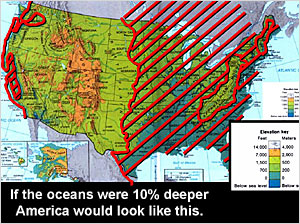 If you raised the oceans just 10%, this is what America would look like. One little island over in Appalachia and all the Rocky Mountain area, and that's it. All of Central United States would be flooded. Did you know Chicago is only 600 feet (200 m) above sea level? 600 feet, you know, from here to the stop sign, two football fields. That is how high Chicago is above sea level. If you lowered the oceans a few hundred feet then Florida would be huge. Cuba would be annexed to Florida. I believe, during the end of the Flood; as the oceans filled in, everything got stabilized; and then the ice caps melted back raising the ocean levels even more. Probably the Atlantic Ocean got too full and spilled over into the Gulf of Mexico. We'll cover more on that in a minute. Pensacola Bay and Mobile Bay are about seven feet deep. You can stand up just about any place out there. If you raised the oceans just 10%, this is what America would look like. One little island over in Appalachia and all the Rocky Mountain area, and that's it. All of Central United States would be flooded. Did you know Chicago is only 600 feet (200 m) above sea level? 600 feet, you know, from here to the stop sign, two football fields. That is how high Chicago is above sea level. If you lowered the oceans a few hundred feet then Florida would be huge. Cuba would be annexed to Florida. I believe, during the end of the Flood; as the oceans filled in, everything got stabilized; and then the ice caps melted back raising the ocean levels even more. Probably the Atlantic Ocean got too full and spilled over into the Gulf of Mexico. We'll cover more on that in a minute. Pensacola Bay and Mobile Bay are about seven feet deep. You can stand up just about any place out there.
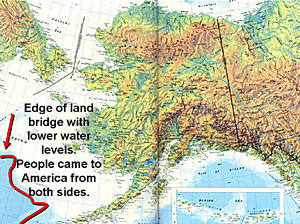 |
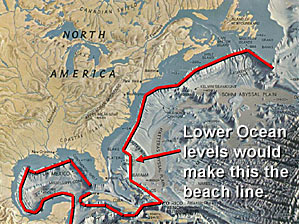 |
 If you lowered the waters a few hundred feet, Australia would be connected to Vietnam. The water between Australia and Vietnam is very shallow. If you lowered the waters a few hundred feet, Australia would be connected to Vietnam. The water between Australia and Vietnam is very shallow. 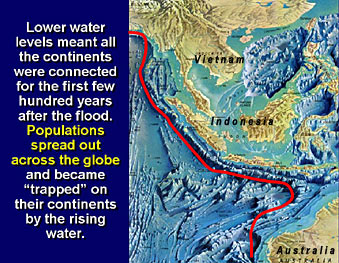 So, the kangaroos, people say: “How did the kangaroos get to Australia?” - “Uhh, they hopped.” That is how they get everywhere. See, kangaroos, and wombats, and koalas are non-aggressive. I mean, compared to tigers they are just not very aggressive. So when the animals got off the ark over here in Turkey, where it landed, they're gonna start spreading out and establishing their territory. And the kangaroos got his home and he is raising his family and all of a sudden the tigers come in, “Rrrr..., I want this property!” - “Ok.” So, rather than fight, they run. Less aggressive animals would constantly be pushed to the migration fringe, to the edge, ok. They would rather run than fight. And they ended up; you know, over generations, over maybe, who knows, a hundred years or so; they keep spreading out. And those that don't run get killed. And they end up in Australia, down here. But at the same time; while they are being pushed to the edge of the migration fringe; the water is coming up, because the ice caps are melting back. And as the ice caps melt back, the water comes up; and all of a sudden Australia is protected, it is now an island, where it used to be part of the mainland. And they just got as far away as they could get from the tigers, and that is where they got stuck, in Australia. So, the kangaroos, people say: “How did the kangaroos get to Australia?” - “Uhh, they hopped.” That is how they get everywhere. See, kangaroos, and wombats, and koalas are non-aggressive. I mean, compared to tigers they are just not very aggressive. So when the animals got off the ark over here in Turkey, where it landed, they're gonna start spreading out and establishing their territory. And the kangaroos got his home and he is raising his family and all of a sudden the tigers come in, “Rrrr..., I want this property!” - “Ok.” So, rather than fight, they run. Less aggressive animals would constantly be pushed to the migration fringe, to the edge, ok. They would rather run than fight. And they ended up; you know, over generations, over maybe, who knows, a hundred years or so; they keep spreading out. And those that don't run get killed. And they end up in Australia, down here. But at the same time; while they are being pushed to the edge of the migration fringe; the water is coming up, because the ice caps are melting back. And as the ice caps melt back, the water comes up; and all of a sudden Australia is protected, it is now an island, where it used to be part of the mainland. And they just got as far away as they could get from the tigers, and that is where they got stuck, in Australia.
 The continental shelf The continental shelf
 |
And we have a continental shelf today, because of the ice melting back, adding depth to the oceans. If the earth was shrunk down to the size of this globe you couldn't even find Mount Everest. Have you ever seen those globes where you can feel the bumps on them? You can feel the mountains? That's baloney. They have to greatly exaggerate those mountains. If you shrank the earth down to the size of a cue ball to play pool with, the earth would be rounder and smoother than the cue ball. I mean, a 5 mile (8 km) mountain on an 8,000 mile (12,700 km) earth is insignificant. We talked about, raising the oceans completely changes the shapes of the continents, and so does lowering the oceans. I think these erosion canyons and things happened after the Flood. Minneapolis, for instance is 670 feet (204 m) above sea level. Well, the Mississippi River runs from Minneapolis to New Orleans. That is about 1,150 miles (1,850 km) away. As it runs, the Mississippi River drops 670 feet in 1,150 miles. That is 7 inches every mile. (10 cm per 1 km.) The Mississippi has to run a full mile to drop 7 inches. Very low slope, very gently moving, generally. If you built a dam across the Grand Canyon a really big lake would fill in behind it.
 Catastrophes do rearrange landscapes rapidly and can do that on a grand scale; Forming of the Grand Canyon; Eruption of Mount St. Helens (1980) Catastrophes do rearrange landscapes rapidly and can do that on a grand scale; Forming of the Grand Canyon; Eruption of Mount St. Helens (1980)
Grand Canyon: Textbooks say: “Over millions of years the Colorado River carved Grand Canyon from solid rock.” I don't think so. I have studied Grand Canyon pretty actively. Grand Canyon had to be formed as a result of enormous erosion, as we covered on video 4. And you saw in Walt Brown's Hydroplate theory video clip there. Grand Canyon is kind of puzzling because the river loops back and forth. But it also has steep sides. Now, a looping river like the Mississippi is usually an indication of, you know, low slope. Gradually sloping ground so the river loops back and forth. Steep sides usually indicates fast moving river on high slope. Grand Canyon has both, steep sides and loops and meanders. And the evolutionists will say: “Wow, I wonder how that river made that canyon?” - “Ahh, the river didn't make that canyon.” The Flood made Grand Canyon, very very quickly. One catastrophe can really rearrange the real estate. In 1964 there was an earthquake in Alaska that dropped sections of neighborhoods down 40 or 50 feet (12-15 m). I don't think so. I have studied Grand Canyon pretty actively. Grand Canyon had to be formed as a result of enormous erosion, as we covered on video 4. And you saw in Walt Brown's Hydroplate theory video clip there. Grand Canyon is kind of puzzling because the river loops back and forth. But it also has steep sides. Now, a looping river like the Mississippi is usually an indication of, you know, low slope. Gradually sloping ground so the river loops back and forth. Steep sides usually indicates fast moving river on high slope. Grand Canyon has both, steep sides and loops and meanders. And the evolutionists will say: “Wow, I wonder how that river made that canyon?” - “Ahh, the river didn't make that canyon.” The Flood made Grand Canyon, very very quickly. One catastrophe can really rearrange the real estate. In 1964 there was an earthquake in Alaska that dropped sections of neighborhoods down 40 or 50 feet (12-15 m).
| |
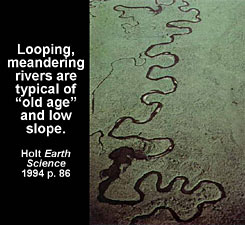 |
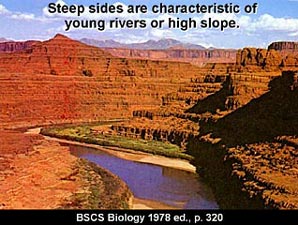 |
 Mount St. Helens (May 18, 1980): I was at Turnagain Heights, preaching up there; going up there again this September, to Anchorage, Alaska. Incredible damage done, just in a few seconds, to that community. When Mount St. Helens blew its top the whole north side of the mountain slid down into the valley. My sister lived up near there when it happened. This whole top of the mountain slid off to the side, uncorked the volcano, and steam and ash came shooting out of the vulcano. Mount St. Helens (May 18, 1980): I was at Turnagain Heights, preaching up there; going up there again this September, to Anchorage, Alaska. Incredible damage done, just in a few seconds, to that community. When Mount St. Helens blew its top the whole north side of the mountain slid down into the valley. My sister lived up near there when it happened. This whole top of the mountain slid off to the side, uncorked the volcano, and steam and ash came shooting out of the vulcano.
At about 100 miles (160 km) an hour, this ash cloud covered the countryside. My sister got about 6 inches (15 cm) in her yard. Sixty some people died as a result of Mount St. Helens 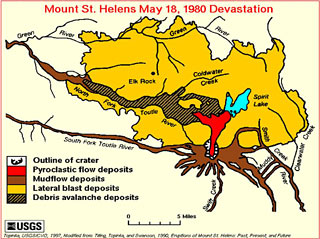 blowing all this ash and steam all over the neighborhood. Some of the ash landed in New York City. Most of it landed in this pattern you can see here on this map. Mount St. Helens, the day of the devastation. There was Pyroclastic flows that flowed, where the red is indicated there. Mud flow deposits, where the brown is. Debris avalanche deposits. Lateral blast, just the blast of steam, and energy coming out, knocked trees down in the light brown area there. And Mount St. Helens was a small volcano, by volcano standards. Nothing like Krakatoa in Indonesia. As the swirling mass came down the mountainside, it automatically sorted into layers. blowing all this ash and steam all over the neighborhood. Some of the ash landed in New York City. Most of it landed in this pattern you can see here on this map. Mount St. Helens, the day of the devastation. There was Pyroclastic flows that flowed, where the red is indicated there. Mud flow deposits, where the brown is. Debris avalanche deposits. Lateral blast, just the blast of steam, and energy coming out, knocked trees down in the light brown area there. And Mount St. Helens was a small volcano, by volcano standards. Nothing like Krakatoa in Indonesia. As the swirling mass came down the mountainside, it automatically sorted into layers. 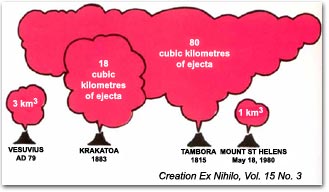 This mud flow, flowing down the mountain, covered up blocks of ice. They were blown off the volcano, when the eruption took place. Here is a semi half-buried in mud. It blew enough mud out, that every person on earth could have a ton of it. You could fill a 10 cubic yard dump truck every second, 24 hours a day for 600 years. This mud flow, flowing down the mountain, covered up blocks of ice. They were blown off the volcano, when the eruption took place. Here is a semi half-buried in mud. It blew enough mud out, that every person on earth could have a ton of it. You could fill a 10 cubic yard dump truck every second, 24 hours a day for 600 years. That's how much mud was moved out of that volcano. As the mud flowed down, it flowed over blocks of ice that were as big as a house, because they were blown off the volcano. It used to be covered by glaciers; beautiful, beautiful mountain. These blocks of ice; under this hot mud; exploded, making erosion pits. This happened in a few seconds. That's how much mud was moved out of that volcano. As the mud flowed down, it flowed over blocks of ice that were as big as a house, because they were blown off the volcano. It used to be covered by glaciers; beautiful, beautiful mountain. These blocks of ice; under this hot mud; exploded, making erosion pits. This happened in a few seconds. 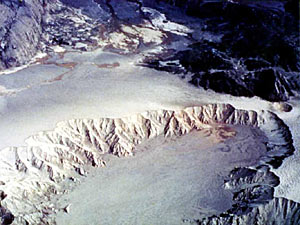 Now some teacher is gonna bring his kids here someday and say: “Boys and girls, do you see this erosion along the side of this pit? This took millions of years.” - “No teacher. My daddy saw this happen. Took about 50 seconds.” Now some teacher is gonna bring his kids here someday and say: “Boys and girls, do you see this erosion along the side of this pit? This took millions of years.” - “No teacher. My daddy saw this happen. Took about 50 seconds.”
 “The landslide of May 18, buried the river and the highway to Spirit Lake to an average depth of 100 feet (30 m). It also buried most other drainages in the 23 square miles of the upper Toutle Valley and plugged the river's mouth. For 22 months the water had no established path to the lower waterway. Then on March 19, 1982, an eruption melted a large snow pack that had accumulated in the crater over the winter. “The landslide of May 18, buried the river and the highway to Spirit Lake to an average depth of 100 feet (30 m). It also buried most other drainages in the 23 square miles of the upper Toutle Valley and plugged the river's mouth. For 22 months the water had no established path to the lower waterway. Then on March 19, 1982, an eruption melted a large snow pack that had accumulated in the crater over the winter. 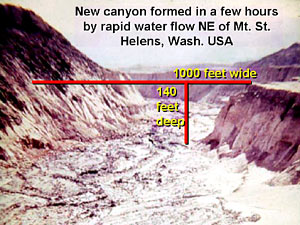 The waters mixed with loose material on the slopes of the mountain, created an enormous mud flow. In nine hours, while no one watched; happened overnight; the mudflow carved an intricate system of drainages over much of the valley and reopened the way to the Pacific Ocean. The drainages included at least three canyons 100 feet (30 m) deep. One is nicknamed ‘The Little Grand Canyon of the Toutle’, because it is a 1/40th scale model of the Grand Canyon.” The waters mixed with loose material on the slopes of the mountain, created an enormous mud flow. In nine hours, while no one watched; happened overnight; the mudflow carved an intricate system of drainages over much of the valley and reopened the way to the Pacific Ocean. The drainages included at least three canyons 100 feet (30 m) deep. One is nicknamed ‘The Little Grand Canyon of the Toutle’, because it is a 1/40th scale model of the Grand Canyon.” The water was backed up behind the mudslide. When it got too deep, it went over the top. Carved out canyons in a hurry. One canyon is 1,000 feet (300 m) wide, 140 feet (45 m) deep. Happened in a few hours. The water was backed up behind the mudslide. When it got too deep, it went over the top. Carved out canyons in a hurry. One canyon is 1,000 feet (300 m) wide, 140 feet (45 m) deep. Happened in a few hours.
Once water starts going over a dam it'll erode out things very, very quickly. You've got one right near here, Grassy Valley, north of Dayton, Tennessee. Where the water goes..., all the whole area drains down into a big hole and then comes out probably eight miles away, in a cave in..., not too far from Dayton. I once went spelunking in there with Kurt Weise, who teaches up at Bryant College. We went in there, he spent a whole life time, many years studying this. This used to be a cave that went probably all the way down to the Chattanooga area; and it's now all collapsed back. Just about five miles of it is left, is all. If you go to Georgia; south of Columbus, Georgia; there is in a town called Lumpkin, Georgia. There is a huge canyon area there. It is a state park. This great, big canyon area started, as a result of, they think, of the Methodist Church not putting gutters on their building back in 1830. And it started causing a little gulley, and the gulley got bigger and bigger and bigger. And now it's several hundred acres of eroded ground; started since 1830. When you go down into the canyons near Mount St. Helens you will see erosion; it was incredible there. And it has..., the sides of the canyon are stratified, nice neat layers.
| |
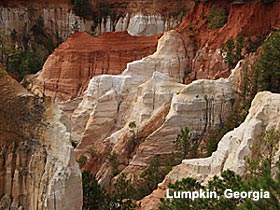 |
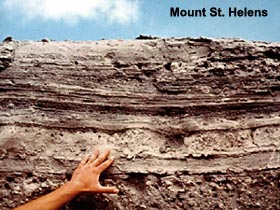 |
They say: “Now, wait a minute, all this mud flowed in here at one time. So why is it stratified?” Well, because moving mud automatically stratifies. Get a jar of dirt, add some water, shake it up, and set it down. It settles into layers for you, very quickly. At the bottom of that big canyon is a little tiny creek called the Toutle River. About from me to that TV right there, 20 feet (7 m) wide. That little river did not make that big canyon, ok. And that little river at the bottom of the Grand Canyon did not make the Grand Canyon either. It was formed by a lot more water than that. So, the textbooks are lying to you when they say that river [Colorado River] made that canyon.
 Blown down trees after Mount St. Helens' eruption; Polystrate trees, quickly forming Blown down trees after Mount St. Helens' eruption; Polystrate trees, quickly forming
Mount St. Helens, when it blew, also blew down bazillions of trees all over the neighborhood. Trees were blown down, it was unbelievable how many trees were blown down. They blocked up rivers; just incredible damage. You can see the huge semi's here next to those giant trees out there in Oregon and Washington State. The trees were hauled out, as many as they could, they hauled out thousands and thousands of truckloads of trees, and just rescued about 10% of the wood. So many trees were blown into Spirit Lake, that you can actually walk across the lake; 2,000 acres of floating wood on Spirit Lake.
| |
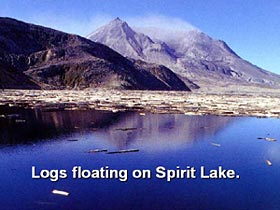 |
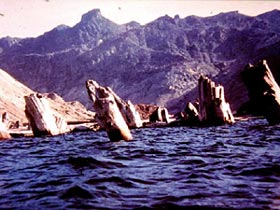 |
Scuba divers went under this floating log mat and noticed something very interesting. Some of the trees are floating in the upright position. They're getting waterlogged, the root end is gonna sink down. As they are floating in the upright position, they slowly sink and stick in the mud at the bottom. Hmm... Many of the trees from Mount St. Helens in the Spirit Lake area, are already being covered by sediments and beginning to petrify, and it just happened 20 years ago. Often times, all over the world, petrified trees are found in the vertical position; petrified, standing up, running through multiple rock layers. The Flood is the only explanation for that. Hmm... Many of the trees from Mount St. Helens in the Spirit Lake area, are already being covered by sediments and beginning to petrify, and it just happened 20 years ago. Often times, all over the world, petrified trees are found in the vertical position; petrified, standing up, running through multiple rock layers. The Flood is the only explanation for that. 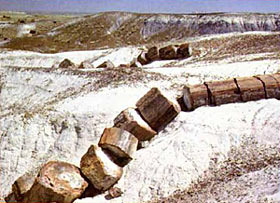 We cover much more on that on videotape #4, about petrified trees in the standing position. When that petrified tree falls down, it is gonna break up into logs. I don't know if you ever cut down a tree for firewood or not, but when you cut a tree down, it does not break up into logs for you automatically. How many noticed that phenomena when you cut the tree down?, ok. It had to happen when the tree was petrified standing, and then fell over, as the dirt eroded away from it. Scuba divers here are going under this log mat to see what's going on. The logs are bouncing into each other as the wind blows around, and they are knocking all the bark off. At the bottom of Spirit Lake is a layer of bark about three feet thick. If it gets buried by any more debris it's gonna turn to coal. We cover much more on that on videotape #4, about petrified trees in the standing position. When that petrified tree falls down, it is gonna break up into logs. I don't know if you ever cut down a tree for firewood or not, but when you cut a tree down, it does not break up into logs for you automatically. How many noticed that phenomena when you cut the tree down?, ok. It had to happen when the tree was petrified standing, and then fell over, as the dirt eroded away from it. Scuba divers here are going under this log mat to see what's going on. The logs are bouncing into each other as the wind blows around, and they are knocking all the bark off. At the bottom of Spirit Lake is a layer of bark about three feet thick. If it gets buried by any more debris it's gonna turn to coal.
| |
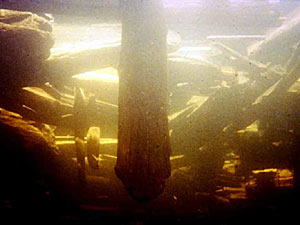 |
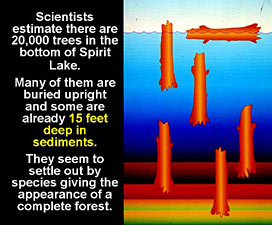 |
 Forming coal does not take ‘millions of years...’; Artifacts found in coal Forming coal does not take ‘millions of years...’; Artifacts found in coal
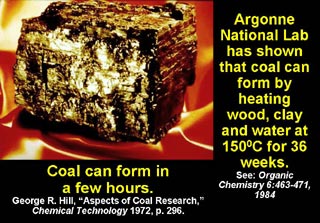 Atheists say: “Well, it takes millions of years to form coal.” - “No, it doesn't. Coal can be formed in a few hours.” There have been many experiments done where they form coal very quickly. During the Flood you'ld get log mats as big as Texas floating around. Where lots of insects could survive for the whole Flood, by the way. Where a human could not. Insects could survive the Flood outside the ark. But these log mats float around and leave behind a debris trail. It is interesting, coal is nearly always found in layers. Seams, coal seams, like in Kentucky or Illinois. I debated Genie Scott the president of an atheist organization, and she said: Atheists say: “Well, it takes millions of years to form coal.” - “No, it doesn't. Coal can be formed in a few hours.” There have been many experiments done where they form coal very quickly. During the Flood you'ld get log mats as big as Texas floating around. Where lots of insects could survive for the whole Flood, by the way. Where a human could not. Insects could survive the Flood outside the ark. But these log mats float around and leave behind a debris trail. It is interesting, coal is nearly always found in layers. Seams, coal seams, like in Kentucky or Illinois. I debated Genie Scott the president of an atheist organization, and she said: 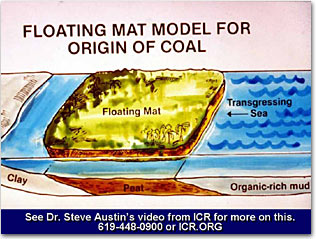 “There are 80 layers of coal in the Midwest.” She is right. She said: “If you look at the amount of coal in the world, the entire biomass, or all the plants of the world today, could not form that much fossil fuel.” She is right again. She said: “Don't you see? There had to be a lot of time to make all this coal.” “There are 80 layers of coal in the Midwest.” She is right. She said: “If you look at the amount of coal in the world, the entire biomass, or all the plants of the world today, could not form that much fossil fuel.” She is right again. She said: “Don't you see? There had to be a lot of time to make all this coal.” No, she is wrong about that. What there were was big log mats floating around during the flood. They would drift back and forth with the tides and the wind, and they would leave behind debris trails; separated by sediments, and then debris trails of logs, and wood, and bark. And you can get 80 layers of coal in one Flood. No, she is wrong about that. What there were was big log mats floating around during the flood. They would drift back and forth with the tides and the wind, and they would leave behind debris trails; separated by sediments, and then debris trails of logs, and wood, and bark. And you can get 80 layers of coal in one Flood.
There is a coal mine in Montana, the coal is 200 feet (70 m) thick, and covering 10,000 square miles. 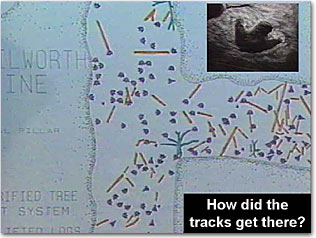 In the roof of one coal mine they find dinosaur tracks. In digging out the coal, and they look up at the ceiling, and there are dinosaur tracks in the ceiling. Well, during the Flood the dinosaurs were walking around, probably in shallow waters, stepping on all this debris, is rotting wood. And left their tracks behind, got filled in by sediments right after they got there. Petrified trees in Alabama are standing up, running through two different coal seams. Oftentimes coal seams, go and dig along, pretty soon they come together; branching coal seams. Absolute proof they formed very quickly. Not millions of years different in age, ok. This coal mine in Montana is 200 feet (60 m) thick; coal. In the roof of one coal mine they find dinosaur tracks. In digging out the coal, and they look up at the ceiling, and there are dinosaur tracks in the ceiling. Well, during the Flood the dinosaurs were walking around, probably in shallow waters, stepping on all this debris, is rotting wood. And left their tracks behind, got filled in by sediments right after they got there. Petrified trees in Alabama are standing up, running through two different coal seams. Oftentimes coal seams, go and dig along, pretty soon they come together; branching coal seams. Absolute proof they formed very quickly. Not millions of years different in age, ok. This coal mine in Montana is 200 feet (60 m) thick; coal. 
 And human made artifacts are found in coal from time to time: And human made artifacts are found in coal from time to time:
- Here is a bell found inside a lump of coal.
- Here is a vessel found in solid rock, supposed to be ‘600 million years old’.
- A lady in Illinois broke open a lump of coal, there is a gold chain inside, 10 inches (25 cm) long.

- A carved stone found in Iowa in a coal mine.

- Here is an iron pot found in a coal mine in Oklahoma.
- Here is the sole of a shoe found in Nevada, inside a piece of coal.
 The waters assuaged...; Unconformity in geology explained The waters assuaged...; Unconformity in geology explained
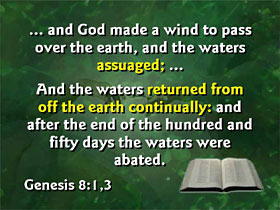 The Bible says: “The waters assuaged,” or sank down. “And the waters returned from off the earth continually.” If a section of the earth sank down, the water would rush in to fill in the hole. But then it would slosh back and forth for awhile. There would be tidal waves going back and forth. The Bible says in Genesis 8: “The waters were ‘going and returning’.” That's the Hebrew phrase, ‘Halak-va-shub’, going and returning. I believe layers of sedimentary mud were laid out during the Flood. And then the mountains arose, the valleys sank down, they would be bent and twisted. And then erosion would take off the surface, depositing more layers on top. That's why we have what's called an unconformity in geology. Best explained by Noah's Flood. The Bible says: “The waters assuaged,” or sank down. “And the waters returned from off the earth continually.” If a section of the earth sank down, the water would rush in to fill in the hole. But then it would slosh back and forth for awhile. There would be tidal waves going back and forth. The Bible says in Genesis 8: “The waters were ‘going and returning’.” That's the Hebrew phrase, ‘Halak-va-shub’, going and returning. I believe layers of sedimentary mud were laid out during the Flood. And then the mountains arose, the valleys sank down, they would be bent and twisted. And then erosion would take off the surface, depositing more layers on top. That's why we have what's called an unconformity in geology. Best explained by Noah's Flood.

 The ark rested, but Noah did not leave the ark until 6 months later The ark rested, but Noah did not leave the ark until 6 months later
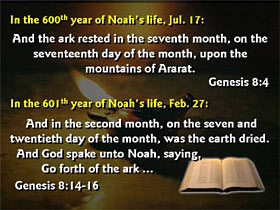 The Bible says: “The ark rested in the seventh month.” Noah didn't get out till the thirteenth month. Stayed in for six extra months, why? The Bible says: “The ark rested in the seventh month.” Noah didn't get out till the thirteenth month. Stayed in for six extra months, why?
- Well, for one thing there is nothing to eat outside;
- The ground is still muddy, and;
- The water was still going and returning. It was not safe to get out of the boat yet. Probably Noah hit bottom, cut off the anchor stones. And then the ark got picked up and moved a few miles; resettled again by another wave coming back as the waters were going and returning. We cover about the Noah's Ark anchor stones on video #3 of our series, and;
- There was nothing outside to build a house with anyway.
 7) The ice caps melted back, gradually raising the ocean levels forming the continental shelf 7) The ice caps melted back, gradually raising the ocean levels forming the continental shelf
The Bible says: “The waters decreased continually.” (Gen. 8:5) So, in the Hovind Theory, the ice caps gradually melted back, slowly raising the ocean levels. During the first few hundred years there was time to spread out around the world. God came down, confused the languages at the Tower of Babel. People said: “I'm out of here,” 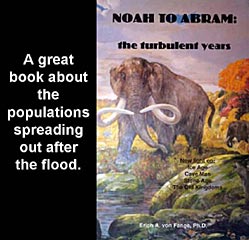 they took off and spread around the world. Had their kids and grandkids. And over a few hundred years the water came up, and they ended up trapped where they are today. There is a great book about the spreading of populations around the world after the Flood. This book is called, Noah to Abram: The turbulent years. It's in our catalog; you can order that. So people came across to America from both sides. Came across the Bering Strait. And you could walk from England, to Iceland, to Greenland, and to America, if the water was lower. As the ice caps melt back they leave behind the obvious features that we see. Yes, there really was an ice age, best explained by the Flood. they took off and spread around the world. Had their kids and grandkids. And over a few hundred years the water came up, and they ended up trapped where they are today. There is a great book about the spreading of populations around the world after the Flood. This book is called, Noah to Abram: The turbulent years. It's in our catalog; you can order that. So people came across to America from both sides. Came across the Bering Strait. And you could walk from England, to Iceland, to Greenland, and to America, if the water was lower. As the ice caps melt back they leave behind the obvious features that we see. Yes, there really was an ice age, best explained by the Flood.
 Life spans for man drastically shortened; The days of Peleg Life spans for man drastically shortened; The days of Peleg
And then in the days of Peleg the earth was divided. Peleg was born 100 years after the Flood. (Gen. 10:25) I think his daddy named him that, because something had changed. There are four theories of what ‘The days of Peleg’ means. What does it mean, ‘divided’? What was divided?
- One theory is the languages and nations were divided at the Tower of Babel.
- Second theory is that the continents moved. I don't buy that one.
- Third theory is the water came up from melting ice. That would divide the continents. (That is probably the one I would follow, the category that I would believe.)
- Number four theory is that the land was surveyed. There got to be so many people, they said: “Look, let's just draw some lines on the ground here, ok. This is my yard, and that is your yard. And let's put a rock right here and a rock right here.” They started surveying the land and dividing the land up. That's natural, you got to do that eventually as populations grow.
 |
 |
So, as the melting ice went into the oceans, the oceans ended up deeper, wider, and colder. Cold water absorbs CO . So that would take away some of the green house protection. And life spans were shorter. The deepest point in the English Channel is only 150 feet deep. You know, not even from here to the back wall. So, we get these ideas: “Wow, it is blue, therefore it's water.” Yeah, it is, but some of it is deep and some of it is not very deep. I think the Flood is the best explanation for that. . So that would take away some of the green house protection. And life spans were shorter. The deepest point in the English Channel is only 150 feet deep. You know, not even from here to the back wall. So, we get these ideas: “Wow, it is blue, therefore it's water.” Yeah, it is, but some of it is deep and some of it is not very deep. I think the Flood is the best explanation for that.
 The existence of cities under water explained The existence of cities under water explained
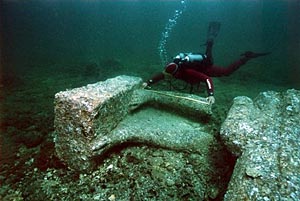 As the oceans filled in, it would gradually get too full and flow over into the Mediterranean Sea. Probably the Straits of Gibraltar were washed out as the water flowed over and backfilled the Mediterranean. Then it got too full and backfilled past Sicily. Maybe that is why they are finding underwater cities. For the first few hundred years people would be building their cities in some of these areas. And then all of a sudden the waters starts coming up. “Hey, guys, we have got to get out of here!” They had to abandon their cities. Underwater cities are found in quite a few places. As the water filled in the Black Sea, they had to abandon the whole civilization there. Underwater cities were found in the Black Sea, under 150 feet of water. They didn't build them there. As the oceans filled in, it would gradually get too full and flow over into the Mediterranean Sea. Probably the Straits of Gibraltar were washed out as the water flowed over and backfilled the Mediterranean. Then it got too full and backfilled past Sicily. Maybe that is why they are finding underwater cities. For the first few hundred years people would be building their cities in some of these areas. And then all of a sudden the waters starts coming up. “Hey, guys, we have got to get out of here!” They had to abandon their cities. Underwater cities are found in quite a few places. As the water filled in the Black Sea, they had to abandon the whole civilization there. Underwater cities were found in the Black Sea, under 150 feet of water. They didn't build them there.
 8) Why did God destroy the world?; After-effects of the Flood are seen today 8) Why did God destroy the world?; After-effects of the Flood are seen today
And today the earth still shows the effects of this Flood to remind us God hates sin. Whenever you are pumping you gas in your car you can think: “Boy, this came as a result of Noah's Flood.” This electricity running these lights is powered by coal probably. They are burning up some of the trees that were growing in the garden of Eden in the pre-Flood world. Every time you see articles in the paper about dinosaur bones, it can remind you of the Flood in the days of Noah. See, God left enough evidence behind that anybody with a brain can look around and say: “Boy, God, you hate sin; I better live for you.” And Satan has worked very hard to take all of the evidence from the planet that shows God's Flood and he's twisted it around. And he is teaching kids today all this evidence shows evolution. He has taken what God has created as evidence and twisting it around.
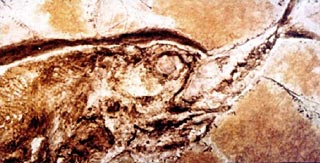 I will leave you with this fossil in your mind here. This is a fossil of a fish swallowing another fish. Either that or the little one is a dentist. I don't know, ok. But neither one thought were gonna die that day. The big one had the little one halfway down and the Flood came, and the mud probably covered them up, and they died. The Bible says: “It is appointed unto man once to die, but after this the judgment.” (Heb. 9:27) I will leave you with this fossil in your mind here. This is a fossil of a fish swallowing another fish. Either that or the little one is a dentist. I don't know, ok. But neither one thought were gonna die that day. The big one had the little one halfway down and the Flood came, and the mud probably covered them up, and they died. The Bible says: “It is appointed unto man once to die, but after this the judgment.” (Heb. 9:27) 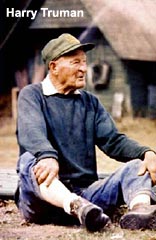 Harry Truman lived right on the side of Mount St. Helens. Tim Berends, a friend of mine from St. Louis; I am on their show every wednesday morning, the Tim and Al Show; he told me he witnessed to Harry and tried to get him saved, and Harry wouldn't listen. Harry cursed and swore, he listened, but he did not get saved. Well, the officials came in and said: “Harry, you live right on the side of Mount St. Helens. This volcano is going to explode. We would like you to move.” Harry said: “I've been living here all of my life, and I'm staying right here.” And he did. He stayed right there. He died. Harry is one of those they never found after the explosion. Isn't that stupid to live on the side of a volcano that is about to explode and refuse to move? Wouldn't listen to the warning. You know, it's just about as stupid to know; hey, God sent his angels, and his messengers, and his Bible and says: “Hey, this world is gonna be destroyed, you better get saved.” But people say: “I don't want to get saved. I want to stay right here.” Well, duh..., you're as dumb as Harry. Harry Truman lived right on the side of Mount St. Helens. Tim Berends, a friend of mine from St. Louis; I am on their show every wednesday morning, the Tim and Al Show; he told me he witnessed to Harry and tried to get him saved, and Harry wouldn't listen. Harry cursed and swore, he listened, but he did not get saved. Well, the officials came in and said: “Harry, you live right on the side of Mount St. Helens. This volcano is going to explode. We would like you to move.” Harry said: “I've been living here all of my life, and I'm staying right here.” And he did. He stayed right there. He died. Harry is one of those they never found after the explosion. Isn't that stupid to live on the side of a volcano that is about to explode and refuse to move? Wouldn't listen to the warning. You know, it's just about as stupid to know; hey, God sent his angels, and his messengers, and his Bible and says: “Hey, this world is gonna be destroyed, you better get saved.” But people say: “I don't want to get saved. I want to stay right here.” Well, duh..., you're as dumb as Harry.
We hope you've enjoyed this video series on creation, evolution and dinosaurs.
Continued to Part 7
| |
|
 |
|
Creation Science Evangelism
488 Pearl Lane
Repton, AL 36475
1 (855) BIG-DINO (244-3466)
Official Website |

Copyright © 2005. Made available on the Internet by Michel Snoeck, A.D. 2013.
This page revised:
29 February, 2024
|
|





 Now there are some idiots out there teaching it was just a local flood in the days of Noah. The Bible says: “The high hills were covered.” It is not a local flood. If the earth were reduced down to the size of this globe right here, all the oceans in the world would only fill about one table spoon. If you smoothed out the earth, the oceans right now, would be average 12,000 feet (3,700 m) deep. But if you smoothed out the earth, they would average 8,000 feet (2,500 m) deep everywhere. There is plenty of water on the earth to cover the planet. Technically, one drop of water would cover the planet, if you spread it real thin, I mean, real thin. I flew back over the Pacific one time, and I came back and said to one of the guys in my office, I said: “Man, that Pacific ocean is huge.” He said: “That's just the top of it.” Wow, what a thought. That is just the top of it. There is a lot of water in these oceans out there.
Now there are some idiots out there teaching it was just a local flood in the days of Noah. The Bible says: “The high hills were covered.” It is not a local flood. If the earth were reduced down to the size of this globe right here, all the oceans in the world would only fill about one table spoon. If you smoothed out the earth, the oceans right now, would be average 12,000 feet (3,700 m) deep. But if you smoothed out the earth, they would average 8,000 feet (2,500 m) deep everywhere. There is plenty of water on the earth to cover the planet. Technically, one drop of water would cover the planet, if you spread it real thin, I mean, real thin. I flew back over the Pacific one time, and I came back and said to one of the guys in my office, I said: “Man, that Pacific ocean is huge.” He said: “That's just the top of it.” Wow, what a thought. That is just the top of it. There is a lot of water in these oceans out there.  When the climbers got to the top of Mount Everest, 1953, the year I was born, they got up here on Mount Everest. They began to find something interesting, petrified clams, on top of Mount Everest. In Peru a couple years ago they found giant oysters up to 11 feet (3 m) across, 2 miles (3 km) above sea level. That's a big oyster. You should see the pearl! And these clams are interesting. I got some on the table down here. They are petrified clams in the closed position. Now think about it for a minute. When a clam dies it opens. The muscle inside relaxes, the ligaments on the outside pull the shell open, almost instantly. When a clam dies, it opens up. How would you get bazillions of petrified clams in the closed position on top of mountains all over the world.
When the climbers got to the top of Mount Everest, 1953, the year I was born, they got up here on Mount Everest. They began to find something interesting, petrified clams, on top of Mount Everest. In Peru a couple years ago they found giant oysters up to 11 feet (3 m) across, 2 miles (3 km) above sea level. That's a big oyster. You should see the pearl! And these clams are interesting. I got some on the table down here. They are petrified clams in the closed position. Now think about it for a minute. When a clam dies it opens. The muscle inside relaxes, the ligaments on the outside pull the shell open, almost instantly. When a clam dies, it opens up. How would you get bazillions of petrified clams in the closed position on top of mountains all over the world.  Even fragile items like eggs are found fossilized. I believe the sediments would settle out of this flood; fine sediments would preserve things in incredible detail. Here is a fossilized jelly fish. We have a fossilized octopus arm in our museum. Soft tissue simply doesn't fossilize under...; very special conditions are required. The Bible says: “The fountains of the deep broke open.” I think the earth got struck by a meteor, the water underneath went shooting to the surface, and the earth was covered with water. See, the earth's crust is kind of interesting.
Even fragile items like eggs are found fossilized. I believe the sediments would settle out of this flood; fine sediments would preserve things in incredible detail. Here is a fossilized jelly fish. We have a fossilized octopus arm in our museum. Soft tissue simply doesn't fossilize under...; very special conditions are required. The Bible says: “The fountains of the deep broke open.” I think the earth got struck by a meteor, the water underneath went shooting to the surface, and the earth was covered with water. See, the earth's crust is kind of interesting.  Pretty thin actually in some spots; 3 to 5 miles (5-8 km) thick under the oceans, and 30 miles (50 km) thick under the continents. The hot water from inside the earth would come shooting out, and it would kill animals that lived within a certain radius of the crack, as the hot water escaped. As the basalt bulged up in the middle, the plates are gonna slide down, explaining as I said earlier about the wrinkled mountains. Take a look at these mountains in British Columbia. They've been pressed from the end, wrinkled up. What happened? As the water came shooting out, the hot water would kill all sorts of things within a certain radius. If you poured a gallon of boiling water into your aquarium it would kill all the fishes within a certain distance, ok. Until the temperature dissipated.
Pretty thin actually in some spots; 3 to 5 miles (5-8 km) thick under the oceans, and 30 miles (50 km) thick under the continents. The hot water from inside the earth would come shooting out, and it would kill animals that lived within a certain radius of the crack, as the hot water escaped. As the basalt bulged up in the middle, the plates are gonna slide down, explaining as I said earlier about the wrinkled mountains. Take a look at these mountains in British Columbia. They've been pressed from the end, wrinkled up. What happened? As the water came shooting out, the hot water would kill all sorts of things within a certain radius. If you poured a gallon of boiling water into your aquarium it would kill all the fishes within a certain distance, ok. Until the temperature dissipated.

 All over the world little tiny creatures called diatoms are found dead in great big thick beds called, diatomaceous earth. These diatoms are super tiny. It takes about 1,000 years to get an inch of dead diatoms at the bottom of the ocean. They very slowly accumulate. When it dries out they pack it into a special powder called, diatomaceous earth. It is used for all sorts of things. It is used as kitty litter. It is used as oil dry. Diatomaceous earth is used in swimming pool filters. Used in bricks, used in aspirin, it's used in medicines, it's used in all sorts of strange things you would never think of; diatomaceous earth, because it is so absorbent.
All over the world little tiny creatures called diatoms are found dead in great big thick beds called, diatomaceous earth. These diatoms are super tiny. It takes about 1,000 years to get an inch of dead diatoms at the bottom of the ocean. They very slowly accumulate. When it dries out they pack it into a special powder called, diatomaceous earth. It is used for all sorts of things. It is used as kitty litter. It is used as oil dry. Diatomaceous earth is used in swimming pool filters. Used in bricks, used in aspirin, it's used in medicines, it's used in all sorts of strange things you would never think of; diatomaceous earth, because it is so absorbent.  I was in Lompoc, California, preaching, and I went to visit the world's largest diatomaceous earth quarry.
I was in Lompoc, California, preaching, and I went to visit the world's largest diatomaceous earth quarry.

 Moving water does very interesting phenomena. As water is moving it automatically sorts things. It can form five or six layers simultaneously. There is a good video tape called: Experiments in Stratification that shows the top strata can
Moving water does very interesting phenomena. As water is moving it automatically sorts things. It can form five or six layers simultaneously. There is a good video tape called: Experiments in Stratification that shows the top strata can  actually be older than the bottom strata. If the water if moving, it forms multiple layers simultaneously. Moving water does some strange things. How many have ever seen those things you buy at the store with two pieces of glass and different colored sand in between? When you flip it over it forms all these layers real quickly, ok. It doesn't take a long time, stratification can happen very quickly. Underwater landslides, like the one we saw in Indonesia in 2004, it is called a turbidity current, they can do enormous damage under water. Causing tsunamis on the surface which killed 250,000 people. In 1929 there was an underwater landslide that traveled 70 miles (110 km) an hour; cut two Transatlantic cables. That one landslide covered 40,000 square miles. That's about the size of Ohio. One landslide underwater.
actually be older than the bottom strata. If the water if moving, it forms multiple layers simultaneously. Moving water does some strange things. How many have ever seen those things you buy at the store with two pieces of glass and different colored sand in between? When you flip it over it forms all these layers real quickly, ok. It doesn't take a long time, stratification can happen very quickly. Underwater landslides, like the one we saw in Indonesia in 2004, it is called a turbidity current, they can do enormous damage under water. Causing tsunamis on the surface which killed 250,000 people. In 1929 there was an underwater landslide that traveled 70 miles (110 km) an hour; cut two Transatlantic cables. That one landslide covered 40,000 square miles. That's about the size of Ohio. One landslide underwater. 

 Here is four animals that are found fossilized in the swimming position. Their heads held up high out of the water. I beleive they probably got caught in the mud as the mud settled under the water. And they drowned or died in this swimming position. In one place in Africa called the Karroo formation, they said: “There are 800,000 million skeletons of vertebrate animals.”
Here is four animals that are found fossilized in the swimming position. Their heads held up high out of the water. I beleive they probably got caught in the mud as the mud settled under the water. And they drowned or died in this swimming position. In one place in Africa called the Karroo formation, they said: “There are 800,000 million skeletons of vertebrate animals.” Two horse hooves were found petrified in Oregon.
Two horse hooves were found petrified in Oregon.  If you can locate the owner of the reel, and get me in touch with him, I wanna see if he wants to put it on loan in our museum. And anybody who can find me the owner Dan Jones, find me the guy, get me his phone number, and let me talk to him, I'll give you $50. Do some research, if some slouch up here in Tennessee wanna work on that one. “UTC geology experts cannot explain this.” How could a fishing reel be found in rock?
If you can locate the owner of the reel, and get me in touch with him, I wanna see if he wants to put it on loan in our museum. And anybody who can find me the owner Dan Jones, find me the guy, get me his phone number, and let me talk to him, I'll give you $50. Do some research, if some slouch up here in Tennessee wanna work on that one. “UTC geology experts cannot explain this.” How could a fishing reel be found in rock? 

 A guy got found along a beach in Montana, that was petrified, a petrified man. The man found in Fort Benton, Montana; it was in 1897, found by Tom Dunbar; the guy was 5 feet, 8 inches tall. Many medical doctors examined him. They said: “Man, this is a petrified complete human, not [just] the bones, the complete person, petrified.”
A guy got found along a beach in Montana, that was petrified, a petrified man. The man found in Fort Benton, Montana; it was in 1897, found by Tom Dunbar; the guy was 5 feet, 8 inches tall. Many medical doctors examined him. They said: “Man, this is a petrified complete human, not [just] the bones, the complete person, petrified.”  Here are petrified sacks of flour found in Eureka Springs, Arkansas.
Here are petrified sacks of flour found in Eureka Springs, Arkansas.  He's seven years old. He said: “Brother Hovind, I put these acorns in a bucket of water hoping they would sprout. And, I forgot about them.” A year later when mama found them on the back porch. They had turned to stone in a bucket of water. Petrified acorns.
He's seven years old. He said: “Brother Hovind, I put these acorns in a bucket of water hoping they would sprout. And, I forgot about them.” A year later when mama found them on the back porch. They had turned to stone in a bucket of water. Petrified acorns. There is an article in Handy Farm Devices published 1909 on how to make petrified wood. For centuries people have known how to make petrified wood, so that it'll last longer.
There is an article in Handy Farm Devices published 1909 on how to make petrified wood. For centuries people have known how to make petrified wood, so that it'll last longer.
 Which is what happened at the Glenn Canyon Dam in Arizona. The water got moving too fast; it sucked the sides of the rock right off the canyon wall. Within just about 20 seconds it made an area the size of a basketball court, four feet deep. Sucking rocks right off the sides because of cavitation.
Which is what happened at the Glenn Canyon Dam in Arizona. The water got moving too fast; it sucked the sides of the rock right off the canyon wall. Within just about 20 seconds it made an area the size of a basketball court, four feet deep. Sucking rocks right off the sides because of cavitation. 
 One guy took a giant aquarium and he put a hot water bottle in the bottom, a big rubber bladder. He put a bazillion little holes in it, and he it hooked to a hose. He put this in the bottom of his aquarium. empty aquarium. And then he took a cement mixer and mixed up rocks, gravel, sand, all kinds of stuff, mixed them together; including dead fish, amphibians, reptiles, and mammals. Mixed them all together and dumped them into the aquarium. When he turned the hose on, the aquarium began filling from the bottom, as the water is going through this hot water bottle. Well, as it lifts up from the water coming up, it's gonna automatically lift things, and they are gonna fall back down, liquefaction; and they are gonna sort themselves by density. He discovered, as it filled the aquarium, it sorted everything in the order of birds, mammals, reptiles, and amphibians. Well, that is the order they are gonna tell you they evolved in. If you just remember the word ‘FARM’; F-A-R-M; fish would be at the bottom: Fish, Amphibian, Reptile, Mammal.
One guy took a giant aquarium and he put a hot water bottle in the bottom, a big rubber bladder. He put a bazillion little holes in it, and he it hooked to a hose. He put this in the bottom of his aquarium. empty aquarium. And then he took a cement mixer and mixed up rocks, gravel, sand, all kinds of stuff, mixed them together; including dead fish, amphibians, reptiles, and mammals. Mixed them all together and dumped them into the aquarium. When he turned the hose on, the aquarium began filling from the bottom, as the water is going through this hot water bottle. Well, as it lifts up from the water coming up, it's gonna automatically lift things, and they are gonna fall back down, liquefaction; and they are gonna sort themselves by density. He discovered, as it filled the aquarium, it sorted everything in the order of birds, mammals, reptiles, and amphibians. Well, that is the order they are gonna tell you they evolved in. If you just remember the word ‘FARM’; F-A-R-M; fish would be at the bottom: Fish, Amphibian, Reptile, Mammal. 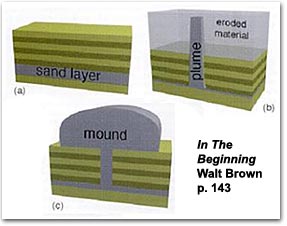
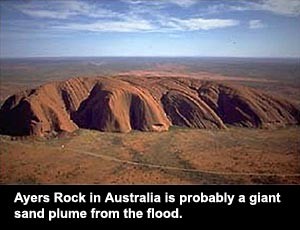
 Evolutionists will say: “Hovind, don't you know that birds are found on top? That proves that birds evolved last.” And: “Clams are found at the bottom. That proves clams evolved first.” I say: “Well, there's a better explanation. You know, maybe clams are found at the bottom because of their habitat. You know, that's where they live.” A clam would be the first one buried in a Flood. I mean, he's already at the bottom. Hello! A bird's gonna be the last one buried because he can fly around until he runs out of gas. Maybe they are sorted based upon their intelligence. As far as anyone can figure out, you know, clams are not too bright. Maybe they are sorted based upon their mobility. Clams cannot run very fast. Maybe they are sorted based upon their body density. Clam shells are heavier than bird feathers. So the sorting of the fossils, if there is any, is not explained by evolution. It is much better explained by a Flood.
Evolutionists will say: “Hovind, don't you know that birds are found on top? That proves that birds evolved last.” And: “Clams are found at the bottom. That proves clams evolved first.” I say: “Well, there's a better explanation. You know, maybe clams are found at the bottom because of their habitat. You know, that's where they live.” A clam would be the first one buried in a Flood. I mean, he's already at the bottom. Hello! A bird's gonna be the last one buried because he can fly around until he runs out of gas. Maybe they are sorted based upon their intelligence. As far as anyone can figure out, you know, clams are not too bright. Maybe they are sorted based upon their mobility. Clams cannot run very fast. Maybe they are sorted based upon their body density. Clam shells are heavier than bird feathers. So the sorting of the fossils, if there is any, is not explained by evolution. It is much better explained by a Flood. 

 do you believe in a worldwide flood in the days of Noah?” He said: “I believe in a universal flood.” Well, that's just a deceitful answer, ok. I said: “What do you mean, a ‘universal flood’?” He said: “Well, it flooded Noah's little universe. Just..., it flooded the valley that he lived in.” I said: “Will you answer a question then, for me, please? If it's just a local flood that floods Noah's valley, why would God tell Noah to build that huge boat, and then to fill it full of animals, and to stay in there for a year? Why not tell Noah ...to move?” This local flood idea is dumb. Capital D, Dumb, ok!
do you believe in a worldwide flood in the days of Noah?” He said: “I believe in a universal flood.” Well, that's just a deceitful answer, ok. I said: “What do you mean, a ‘universal flood’?” He said: “Well, it flooded Noah's little universe. Just..., it flooded the valley that he lived in.” I said: “Will you answer a question then, for me, please? If it's just a local flood that floods Noah's valley, why would God tell Noah to build that huge boat, and then to fill it full of animals, and to stay in there for a year? Why not tell Noah ...to move?” This local flood idea is dumb. Capital D, Dumb, ok!  People say: “Well, if the world was covered with water, where did it all go?,” ok. During the last few months of the Flood, the unstable plates of the crust of the earth would began to shift, and in some place sink down. Thin spots would sink down, other places lifted up. The water is gonna rush off and fill in the holes very quickly. It would cause erosion very quickly. The Bible says in Psalm 104 (v. 7-8): “At thy rebuke they fled.” This is talking about the water. “At the voice of thy thunder they hasted away.” The water rushed off. “They go up by the mountains, they go down by the valleys unto the place which thou hast founded for them,” which is, the oceans. What happened was, the mountains lifted up; the water rushed off into the new low places.
People say: “Well, if the world was covered with water, where did it all go?,” ok. During the last few months of the Flood, the unstable plates of the crust of the earth would began to shift, and in some place sink down. Thin spots would sink down, other places lifted up. The water is gonna rush off and fill in the holes very quickly. It would cause erosion very quickly. The Bible says in Psalm 104 (v. 7-8): “At thy rebuke they fled.” This is talking about the water. “At the voice of thy thunder they hasted away.” The water rushed off. “They go up by the mountains, they go down by the valleys unto the place which thou hast founded for them,” which is, the oceans. What happened was, the mountains lifted up; the water rushed off into the new low places.  If we filled this auditorium four feet deep in water; preacher would be upset, I'm sure, but...; let's just do it for a science experiment, for the good of science. We're gonna fill the auditorium four feet deep in water, then we're gonna get all the guys in the school to pick up that end of the building, krrr... They pick up that end, all the water is gonna rush down, whoosh..., over to this end of the building. It's common sense. If the earth were covered with water and some places began to sink down, other places are gonna lift up. It is kinda like a water bed. How many have ever slept on a water bed before? You know, my wife is only five feet tall. When she gets sound asleep on a side of the water bed...; I don't like water beds; we don't have one, but we have slept on them a couple of times. You wait till she is sound asleep on her side. I tiptoe in; stand up on a chair, and jump up as high as I can. Shw...boom..., and land on my side of the water bed. She goes, pwhooo..., up to the ceiling, comes down, whehehe..., and I sleep on the couch, because I don't like water beds anyway, but... Sure, if one place goes down, someplace else is going to lift up. The crust of the earth probably did a lot of flexing during the time of Noah's Flood, and probably for the next few hundred or maybe even a few thousand years after the Flood. Actually, I think it is still moving around a little bit, causing the earthquakes.
If we filled this auditorium four feet deep in water; preacher would be upset, I'm sure, but...; let's just do it for a science experiment, for the good of science. We're gonna fill the auditorium four feet deep in water, then we're gonna get all the guys in the school to pick up that end of the building, krrr... They pick up that end, all the water is gonna rush down, whoosh..., over to this end of the building. It's common sense. If the earth were covered with water and some places began to sink down, other places are gonna lift up. It is kinda like a water bed. How many have ever slept on a water bed before? You know, my wife is only five feet tall. When she gets sound asleep on a side of the water bed...; I don't like water beds; we don't have one, but we have slept on them a couple of times. You wait till she is sound asleep on her side. I tiptoe in; stand up on a chair, and jump up as high as I can. Shw...boom..., and land on my side of the water bed. She goes, pwhooo..., up to the ceiling, comes down, whehehe..., and I sleep on the couch, because I don't like water beds anyway, but... Sure, if one place goes down, someplace else is going to lift up. The crust of the earth probably did a lot of flexing during the time of Noah's Flood, and probably for the next few hundred or maybe even a few thousand years after the Flood. Actually, I think it is still moving around a little bit, causing the earthquakes.  Did you know there are underwater; at the bottom of the ocean; underwater thermal vents? There is hot water squirting up from the bottom of the ocean. Well, duh..., where is it coming from? Doesn't it have to come from down lower than that? There is still water in the crust of the earth, trapped down there. The ocean crust is pretty thin, about 3 to 5 miles (5-8 km) thick. Continental crust is about 30 miles (50 km) thick. Any earth science teacher can tell you that.
Did you know there are underwater; at the bottom of the ocean; underwater thermal vents? There is hot water squirting up from the bottom of the ocean. Well, duh..., where is it coming from? Doesn't it have to come from down lower than that? There is still water in the crust of the earth, trapped down there. The ocean crust is pretty thin, about 3 to 5 miles (5-8 km) thick. Continental crust is about 30 miles (50 km) thick. Any earth science teacher can tell you that.  That's been pretty well determined from, you know, reading the S- and P-waves from earthquakes take place. The earth is cracked up, I understand, and a bunch of plates are moving around, and they are still moving a little bit. Pensacola has zero chance of an earthquake according to this map, some places have a real good chance of an earthquake. The cracks have been found and they are still active, still moving. The earth would be like a big water balloon. It would be floating, flexing up and down. Now, we're talking just a few miles, on an 8,000 mile earth. A few miles of movement is close to zero in scale here. The water would run off, causing enormous erosion canyons.
That's been pretty well determined from, you know, reading the S- and P-waves from earthquakes take place. The earth is cracked up, I understand, and a bunch of plates are moving around, and they are still moving a little bit. Pensacola has zero chance of an earthquake according to this map, some places have a real good chance of an earthquake. The cracks have been found and they are still active, still moving. The earth would be like a big water balloon. It would be floating, flexing up and down. Now, we're talking just a few miles, on an 8,000 mile earth. A few miles of movement is close to zero in scale here. The water would run off, causing enormous erosion canyons. 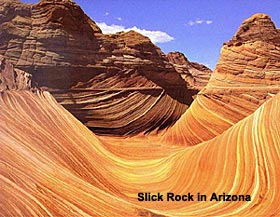
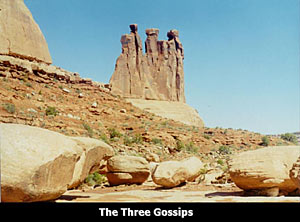
 They'll tell you: “It takes millions of years to erode all this stuff. Yes, boys and girls, millions of years of erosion.” I don't think so. That is in my backyard, here's my inkpen on top of it. At a pile of dirt out there, got rained on one time, and it made erosion marks. Here is ‘millions of years’ of erosion, along a highway built a few months ago. There is ‘millions of years’ of erosion? Nooo..., I don't think so. I think that's my glasses sitting right there. Erosion can take place quickly. There are obviously great erosion marks in Washington and Idaho, from the Missoula Flood. There was an ice dam. I believe this would happen after the real Flood of Noah's time, maybe a few hundred years later. Ice caps were melting back, but a big bunch of water got trapped; all of a sudden it released itself, throooth..., shot down to Portland, Oregon. It did incredible erosion. Along the way there is a waterfall, one of the largest waterfalls in the world, called Dry Falls, Washington. But there is no water going over this waterfall; totally dry. But when it was flowing, it was probably bigger than all the waterfalls in the world put together. You can study about Dry Falls, Washington, if you want to read more on that.
They'll tell you: “It takes millions of years to erode all this stuff. Yes, boys and girls, millions of years of erosion.” I don't think so. That is in my backyard, here's my inkpen on top of it. At a pile of dirt out there, got rained on one time, and it made erosion marks. Here is ‘millions of years’ of erosion, along a highway built a few months ago. There is ‘millions of years’ of erosion? Nooo..., I don't think so. I think that's my glasses sitting right there. Erosion can take place quickly. There are obviously great erosion marks in Washington and Idaho, from the Missoula Flood. There was an ice dam. I believe this would happen after the real Flood of Noah's time, maybe a few hundred years later. Ice caps were melting back, but a big bunch of water got trapped; all of a sudden it released itself, throooth..., shot down to Portland, Oregon. It did incredible erosion. Along the way there is a waterfall, one of the largest waterfalls in the world, called Dry Falls, Washington. But there is no water going over this waterfall; totally dry. But when it was flowing, it was probably bigger than all the waterfalls in the world put together. You can study about Dry Falls, Washington, if you want to read more on that. 

 It is also interesting to notice, nearly all of the mountain ranges in the world follow the coastlines. As Walt Brown mentioned in his Hydroplate theory, that is probably because they formed at the same time as the result of the same event. The mountains arose, the valleys sank down. The flood in Texas, the Guadalupe River flooded, had 30 inches of rain in one week. Water overflowed the spillway. And did an unbelievable damage to the area around, you know, this city, when the dam overflowed. It carved a canyon a mile long, 50 feet (15 m) deep, and hundreds of yards wide through solid limestone rock. “Guadalupe River residents rebuilding after flood losses,” interesting, “70 feet (22 m) deep in some places.”
It is also interesting to notice, nearly all of the mountain ranges in the world follow the coastlines. As Walt Brown mentioned in his Hydroplate theory, that is probably because they formed at the same time as the result of the same event. The mountains arose, the valleys sank down. The flood in Texas, the Guadalupe River flooded, had 30 inches of rain in one week. Water overflowed the spillway. And did an unbelievable damage to the area around, you know, this city, when the dam overflowed. It carved a canyon a mile long, 50 feet (15 m) deep, and hundreds of yards wide through solid limestone rock. “Guadalupe River residents rebuilding after flood losses,” interesting, “70 feet (22 m) deep in some places.”

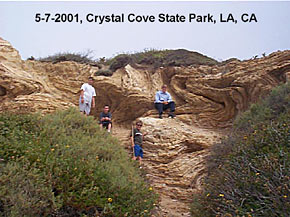
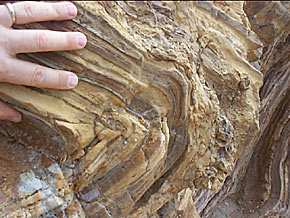
 who knows how far, and then squirts out the side of the canyon, into Grand Canyon.” Well, if it keeps eroding away that sinkhole, it's gonna eventually wash out and make another side canyon. After the Flood in Noah's time the surface would dry out first, leaving the inside still soft muddy ground. Which would slowly dry out; as it dries, shrink and contract. Causing wrinkling on the surface. As mountains lifted up it would cause metamorphic rock to be formed. This formed, I believe, during and after Noah's Flood.
who knows how far, and then squirts out the side of the canyon, into Grand Canyon.” Well, if it keeps eroding away that sinkhole, it's gonna eventually wash out and make another side canyon. After the Flood in Noah's time the surface would dry out first, leaving the inside still soft muddy ground. Which would slowly dry out; as it dries, shrink and contract. Causing wrinkling on the surface. As mountains lifted up it would cause metamorphic rock to be formed. This formed, I believe, during and after Noah's Flood.  Skeptics say: “Oh wait, excuse me now, how did all these kangaroos get to Australia? And why are they only there?” I believe, after the Flood was over, the oceans were smaller than they are today. Today, of the earth's surface 70% is under water. I don't think it was that way right after Noah got off the Ark. If you look at this map you can see England and Ireland were part of France. If you lower the water just a few hundred feet, everything would dry up in between England and France. That was probably the beach line way out there. You can see it from this satellite view. If you look very carefully you can see that's England and Ireland there. You can see under the water and see the beach line, where it used to be. The water is really very shallow along there. Between Alaska and Russia the water is only 60 feet (20 m) deep. About from here to that pole. Only 60 feet. If you lowered the oceans 60 feet, Russia and Alaska would be connected. If you raised the oceans, all of Central America would flood.
Skeptics say: “Oh wait, excuse me now, how did all these kangaroos get to Australia? And why are they only there?” I believe, after the Flood was over, the oceans were smaller than they are today. Today, of the earth's surface 70% is under water. I don't think it was that way right after Noah got off the Ark. If you look at this map you can see England and Ireland were part of France. If you lower the water just a few hundred feet, everything would dry up in between England and France. That was probably the beach line way out there. You can see it from this satellite view. If you look very carefully you can see that's England and Ireland there. You can see under the water and see the beach line, where it used to be. The water is really very shallow along there. Between Alaska and Russia the water is only 60 feet (20 m) deep. About from here to that pole. Only 60 feet. If you lowered the oceans 60 feet, Russia and Alaska would be connected. If you raised the oceans, all of Central America would flood.  If you raised the oceans just 10%, this is what America would look like. One little island over in Appalachia and all the Rocky Mountain area, and that's it. All of Central United States would be flooded. Did you know Chicago is only 600 feet (200 m) above sea level? 600 feet, you know, from here to the stop sign, two football fields. That is how high Chicago is above sea level. If you lowered the oceans a few hundred feet then Florida would be huge. Cuba would be annexed to Florida. I believe, during the end of the Flood; as the oceans filled in, everything got stabilized; and then the ice caps melted back raising the ocean levels even more. Probably the Atlantic Ocean got too full and spilled over into the Gulf of Mexico. We'll cover more on that in a minute. Pensacola Bay and Mobile Bay are about seven feet deep. You can stand up just about any place out there.
If you raised the oceans just 10%, this is what America would look like. One little island over in Appalachia and all the Rocky Mountain area, and that's it. All of Central United States would be flooded. Did you know Chicago is only 600 feet (200 m) above sea level? 600 feet, you know, from here to the stop sign, two football fields. That is how high Chicago is above sea level. If you lowered the oceans a few hundred feet then Florida would be huge. Cuba would be annexed to Florida. I believe, during the end of the Flood; as the oceans filled in, everything got stabilized; and then the ice caps melted back raising the ocean levels even more. Probably the Atlantic Ocean got too full and spilled over into the Gulf of Mexico. We'll cover more on that in a minute. Pensacola Bay and Mobile Bay are about seven feet deep. You can stand up just about any place out there. 

 So, the kangaroos, people say: “How did the kangaroos get to Australia?” - “Uhh, they hopped.” That is how they get everywhere. See, kangaroos, and wombats, and koalas are non-aggressive. I mean, compared to tigers they are just not very aggressive. So when the animals got off the ark over here in Turkey, where it landed, they're gonna start spreading out and establishing their territory. And the kangaroos got his home and he is raising his family and all of a sudden the tigers come in, “Rrrr..., I want this property!” - “Ok.” So, rather than fight, they run. Less aggressive animals would constantly be pushed to the migration fringe, to the edge, ok. They would rather run than fight. And they ended up; you know, over generations, over maybe, who knows, a hundred years or so; they keep spreading out. And those that don't run get killed. And they end up in Australia, down here. But at the same time; while they are being pushed to the edge of the migration fringe; the water is coming up, because the ice caps are melting back. And as the ice caps melt back, the water comes up; and all of a sudden Australia is protected, it is now an island, where it used to be part of the mainland. And they just got as far away as they could get from the tigers, and that is where they got stuck, in Australia.
So, the kangaroos, people say: “How did the kangaroos get to Australia?” - “Uhh, they hopped.” That is how they get everywhere. See, kangaroos, and wombats, and koalas are non-aggressive. I mean, compared to tigers they are just not very aggressive. So when the animals got off the ark over here in Turkey, where it landed, they're gonna start spreading out and establishing their territory. And the kangaroos got his home and he is raising his family and all of a sudden the tigers come in, “Rrrr..., I want this property!” - “Ok.” So, rather than fight, they run. Less aggressive animals would constantly be pushed to the migration fringe, to the edge, ok. They would rather run than fight. And they ended up; you know, over generations, over maybe, who knows, a hundred years or so; they keep spreading out. And those that don't run get killed. And they end up in Australia, down here. But at the same time; while they are being pushed to the edge of the migration fringe; the water is coming up, because the ice caps are melting back. And as the ice caps melt back, the water comes up; and all of a sudden Australia is protected, it is now an island, where it used to be part of the mainland. And they just got as far away as they could get from the tigers, and that is where they got stuck, in Australia. 


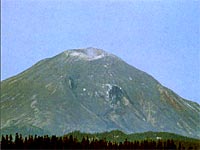
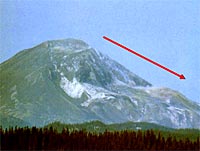
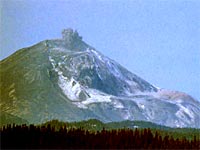
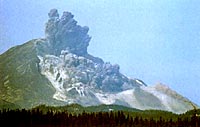
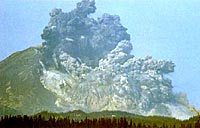
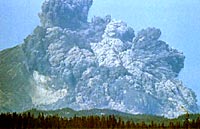
 blowing all this ash and steam all over the neighborhood. Some of the ash landed in New York City. Most of it landed in this pattern you can see here on this map. Mount St. Helens, the day of the devastation. There was Pyroclastic flows that flowed, where the red is indicated there. Mud flow deposits, where the brown is. Debris avalanche deposits. Lateral blast, just the blast of steam, and energy coming out, knocked trees down in the light brown area there. And Mount St. Helens was a small volcano, by volcano standards. Nothing like Krakatoa in Indonesia. As the swirling mass came down the mountainside, it automatically sorted into layers.
blowing all this ash and steam all over the neighborhood. Some of the ash landed in New York City. Most of it landed in this pattern you can see here on this map. Mount St. Helens, the day of the devastation. There was Pyroclastic flows that flowed, where the red is indicated there. Mud flow deposits, where the brown is. Debris avalanche deposits. Lateral blast, just the blast of steam, and energy coming out, knocked trees down in the light brown area there. And Mount St. Helens was a small volcano, by volcano standards. Nothing like Krakatoa in Indonesia. As the swirling mass came down the mountainside, it automatically sorted into layers.  This mud flow, flowing down the mountain, covered up blocks of ice. They were blown off the volcano, when the eruption took place. Here is a semi half-buried in mud. It blew enough mud out, that every person on earth could have a ton of it. You could fill a 10 cubic yard dump truck every second, 24 hours a day for 600 years.
This mud flow, flowing down the mountain, covered up blocks of ice. They were blown off the volcano, when the eruption took place. Here is a semi half-buried in mud. It blew enough mud out, that every person on earth could have a ton of it. You could fill a 10 cubic yard dump truck every second, 24 hours a day for 600 years. Now some teacher is gonna bring his kids here someday and say: “Boys and girls, do you see this erosion along the side of this pit? This took millions of years.” - “No teacher. My daddy saw this happen. Took about 50 seconds.”
Now some teacher is gonna bring his kids here someday and say: “Boys and girls, do you see this erosion along the side of this pit? This took millions of years.” - “No teacher. My daddy saw this happen. Took about 50 seconds.”  The waters mixed with loose material on the slopes of the mountain, created an enormous mud flow. In nine hours, while no one watched; happened overnight; the mudflow carved an intricate system of drainages over much of the valley and reopened the way to the Pacific Ocean. The drainages included at least three canyons 100 feet (30 m) deep. One is nicknamed ‘The Little Grand Canyon of the Toutle’, because it is a 1/40th scale model of the Grand Canyon.”
The waters mixed with loose material on the slopes of the mountain, created an enormous mud flow. In nine hours, while no one watched; happened overnight; the mudflow carved an intricate system of drainages over much of the valley and reopened the way to the Pacific Ocean. The drainages included at least three canyons 100 feet (30 m) deep. One is nicknamed ‘The Little Grand Canyon of the Toutle’, because it is a 1/40th scale model of the Grand Canyon.”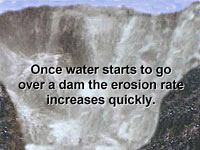
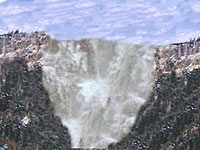
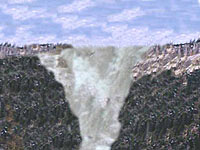
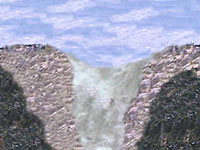
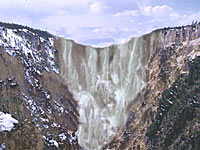
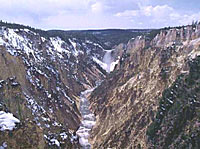


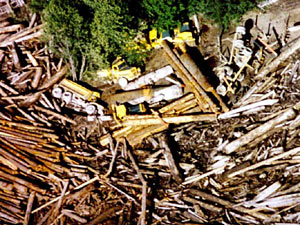
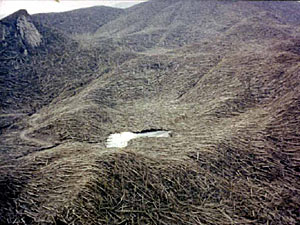


 We cover much more on that on videotape #4, about petrified trees in the standing position. When that petrified tree falls down, it is gonna break up into logs. I don't know if you ever cut down a tree for firewood or not, but when you cut a tree down, it does not break up into logs for you automatically. How many noticed that phenomena when you cut the tree down?, ok. It had to happen when the tree was petrified standing, and then fell over, as the dirt eroded away from it. Scuba divers here are going under this log mat to see what's going on. The logs are bouncing into each other as the wind blows around, and they are knocking all the bark off. At the bottom of Spirit Lake is a layer of bark about three feet thick. If it gets buried by any more debris it's gonna turn to coal.
We cover much more on that on videotape #4, about petrified trees in the standing position. When that petrified tree falls down, it is gonna break up into logs. I don't know if you ever cut down a tree for firewood or not, but when you cut a tree down, it does not break up into logs for you automatically. How many noticed that phenomena when you cut the tree down?, ok. It had to happen when the tree was petrified standing, and then fell over, as the dirt eroded away from it. Scuba divers here are going under this log mat to see what's going on. The logs are bouncing into each other as the wind blows around, and they are knocking all the bark off. At the bottom of Spirit Lake is a layer of bark about three feet thick. If it gets buried by any more debris it's gonna turn to coal. 

 Atheists say: “Well, it takes millions of years to form coal.” - “No, it doesn't. Coal can be formed in a few hours.” There have been many experiments done where they form coal very quickly. During the Flood you'ld get log mats as big as Texas floating around. Where lots of insects could survive for the whole Flood, by the way. Where a human could not. Insects could survive the Flood outside the ark. But these log mats float around and leave behind a debris trail. It is interesting, coal is nearly always found in layers. Seams, coal seams, like in Kentucky or Illinois. I debated Genie Scott the president of an atheist organization, and she said:
Atheists say: “Well, it takes millions of years to form coal.” - “No, it doesn't. Coal can be formed in a few hours.” There have been many experiments done where they form coal very quickly. During the Flood you'ld get log mats as big as Texas floating around. Where lots of insects could survive for the whole Flood, by the way. Where a human could not. Insects could survive the Flood outside the ark. But these log mats float around and leave behind a debris trail. It is interesting, coal is nearly always found in layers. Seams, coal seams, like in Kentucky or Illinois. I debated Genie Scott the president of an atheist organization, and she said:  “There are 80 layers of coal in the Midwest.” She is right. She said: “If you look at the amount of coal in the world, the entire biomass, or all the plants of the world today, could not form that much fossil fuel.” She is right again. She said: “Don't you see? There had to be a lot of time to make all this coal.”
“There are 80 layers of coal in the Midwest.” She is right. She said: “If you look at the amount of coal in the world, the entire biomass, or all the plants of the world today, could not form that much fossil fuel.” She is right again. She said: “Don't you see? There had to be a lot of time to make all this coal.” In the roof of one coal mine they find dinosaur tracks. In digging out the coal, and they look up at the ceiling, and there are dinosaur tracks in the ceiling. Well, during the Flood the dinosaurs were walking around, probably in shallow waters, stepping on all this debris, is rotting wood. And left their tracks behind, got filled in by sediments right after they got there. Petrified trees in Alabama are standing up, running through two different coal seams. Oftentimes coal seams, go and dig along, pretty soon they come together; branching coal seams. Absolute proof they formed very quickly. Not millions of years different in age, ok. This coal mine in Montana is 200 feet (60 m) thick; coal.
In the roof of one coal mine they find dinosaur tracks. In digging out the coal, and they look up at the ceiling, and there are dinosaur tracks in the ceiling. Well, during the Flood the dinosaurs were walking around, probably in shallow waters, stepping on all this debris, is rotting wood. And left their tracks behind, got filled in by sediments right after they got there. Petrified trees in Alabama are standing up, running through two different coal seams. Oftentimes coal seams, go and dig along, pretty soon they come together; branching coal seams. Absolute proof they formed very quickly. Not millions of years different in age, ok. This coal mine in Montana is 200 feet (60 m) thick; coal. 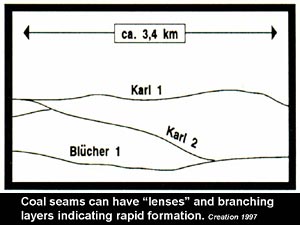
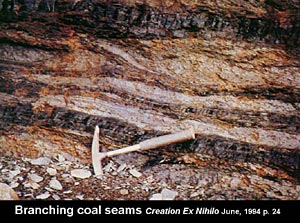
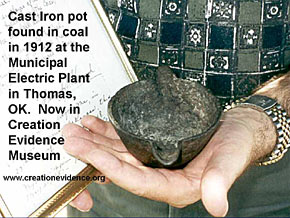

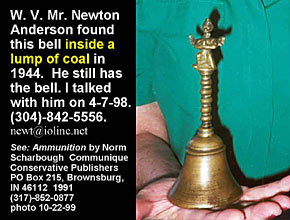
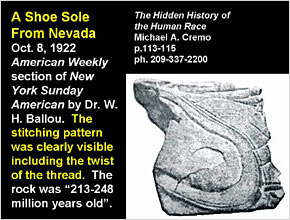
 The Bible says: “The waters assuaged,” or sank down. “And the waters returned from off the earth continually.” If a section of the earth sank down, the water would rush in to fill in the hole. But then it would slosh back and forth for awhile. There would be tidal waves going back and forth. The Bible says in Genesis 8: “The waters were ‘going and returning’.” That's the Hebrew phrase, ‘Halak-va-shub’, going and returning. I believe layers of sedimentary mud were laid out during the Flood. And then the mountains arose, the valleys sank down, they would be bent and twisted. And then erosion would take off the surface, depositing more layers on top. That's why we have what's called an unconformity in geology. Best explained by Noah's Flood.
The Bible says: “The waters assuaged,” or sank down. “And the waters returned from off the earth continually.” If a section of the earth sank down, the water would rush in to fill in the hole. But then it would slosh back and forth for awhile. There would be tidal waves going back and forth. The Bible says in Genesis 8: “The waters were ‘going and returning’.” That's the Hebrew phrase, ‘Halak-va-shub’, going and returning. I believe layers of sedimentary mud were laid out during the Flood. And then the mountains arose, the valleys sank down, they would be bent and twisted. And then erosion would take off the surface, depositing more layers on top. That's why we have what's called an unconformity in geology. Best explained by Noah's Flood. 
 The Bible says: “The ark rested in the seventh month.” Noah didn't get out till the thirteenth month. Stayed in for six extra months, why?
The Bible says: “The ark rested in the seventh month.” Noah didn't get out till the thirteenth month. Stayed in for six extra months, why?  they took off and spread around the world. Had their kids and grandkids. And over a few hundred years the water came up, and they ended up trapped where they are today. There is a great book about the spreading of populations around the world after the Flood. This book is called, Noah to Abram: The turbulent years. It's in our catalog; you can order that. So people came across to America from both sides. Came across the Bering Strait. And you could walk from England, to Iceland, to Greenland, and to America, if the water was lower. As the ice caps melt back they leave behind the obvious features that we see. Yes, there really was an ice age, best explained by the Flood.
they took off and spread around the world. Had their kids and grandkids. And over a few hundred years the water came up, and they ended up trapped where they are today. There is a great book about the spreading of populations around the world after the Flood. This book is called, Noah to Abram: The turbulent years. It's in our catalog; you can order that. So people came across to America from both sides. Came across the Bering Strait. And you could walk from England, to Iceland, to Greenland, and to America, if the water was lower. As the ice caps melt back they leave behind the obvious features that we see. Yes, there really was an ice age, best explained by the Flood. 

 As the oceans filled in, it would gradually get too full and flow over into the Mediterranean Sea. Probably the Straits of Gibraltar were washed out as the water flowed over and backfilled the Mediterranean. Then it got too full and backfilled past Sicily. Maybe that is why they are finding underwater cities. For the first few hundred years people would be building their cities in some of these areas. And then all of a sudden the waters starts coming up. “Hey, guys, we have got to get out of here!” They had to abandon their cities. Underwater cities are found in quite a few places. As the water filled in the Black Sea, they had to abandon the whole civilization there. Underwater cities were found in the Black Sea, under 150 feet of water. They didn't build them there.
As the oceans filled in, it would gradually get too full and flow over into the Mediterranean Sea. Probably the Straits of Gibraltar were washed out as the water flowed over and backfilled the Mediterranean. Then it got too full and backfilled past Sicily. Maybe that is why they are finding underwater cities. For the first few hundred years people would be building their cities in some of these areas. And then all of a sudden the waters starts coming up. “Hey, guys, we have got to get out of here!” They had to abandon their cities. Underwater cities are found in quite a few places. As the water filled in the Black Sea, they had to abandon the whole civilization there. Underwater cities were found in the Black Sea, under 150 feet of water. They didn't build them there.  I will leave you with this fossil in your mind here. This is a fossil of a fish swallowing another fish. Either that or the little one is a dentist. I don't know, ok. But neither one thought were gonna die that day. The big one had the little one halfway down and the Flood came, and the mud probably covered them up, and they died. The Bible says: “It is appointed unto man once to die, but after this the judgment.” (Heb. 9:27)
I will leave you with this fossil in your mind here. This is a fossil of a fish swallowing another fish. Either that or the little one is a dentist. I don't know, ok. But neither one thought were gonna die that day. The big one had the little one halfway down and the Flood came, and the mud probably covered them up, and they died. The Bible says: “It is appointed unto man once to die, but after this the judgment.” (Heb. 9:27)  Harry Truman lived right on the side of Mount St. Helens. Tim Berends, a friend of mine from St. Louis; I am on their show every wednesday morning, the Tim and Al Show; he told me he witnessed to Harry and tried to get him saved, and Harry wouldn't listen. Harry cursed and swore, he listened, but he did not get saved. Well, the officials came in and said: “Harry, you live right on the side of Mount St. Helens. This volcano is going to explode. We would like you to move.” Harry said: “I've been living here all of my life, and I'm staying right here.” And he did. He stayed right there. He died. Harry is one of those they never found after the explosion. Isn't that stupid to live on the side of a volcano that is about to explode and refuse to move? Wouldn't listen to the warning. You know, it's just about as stupid to know; hey, God sent his angels, and his messengers, and his Bible and says: “Hey, this world is gonna be destroyed, you better get saved.” But people say: “I don't want to get saved. I want to stay right here.” Well, duh..., you're as dumb as Harry.
Harry Truman lived right on the side of Mount St. Helens. Tim Berends, a friend of mine from St. Louis; I am on their show every wednesday morning, the Tim and Al Show; he told me he witnessed to Harry and tried to get him saved, and Harry wouldn't listen. Harry cursed and swore, he listened, but he did not get saved. Well, the officials came in and said: “Harry, you live right on the side of Mount St. Helens. This volcano is going to explode. We would like you to move.” Harry said: “I've been living here all of my life, and I'm staying right here.” And he did. He stayed right there. He died. Harry is one of those they never found after the explosion. Isn't that stupid to live on the side of a volcano that is about to explode and refuse to move? Wouldn't listen to the warning. You know, it's just about as stupid to know; hey, God sent his angels, and his messengers, and his Bible and says: “Hey, this world is gonna be destroyed, you better get saved.” But people say: “I don't want to get saved. I want to stay right here.” Well, duh..., you're as dumb as Harry.